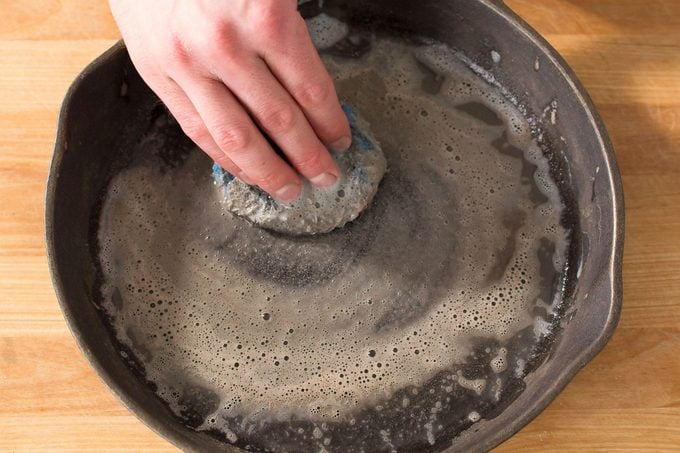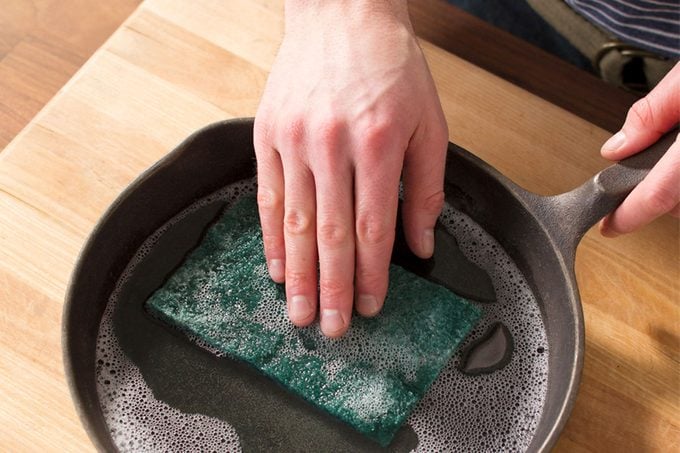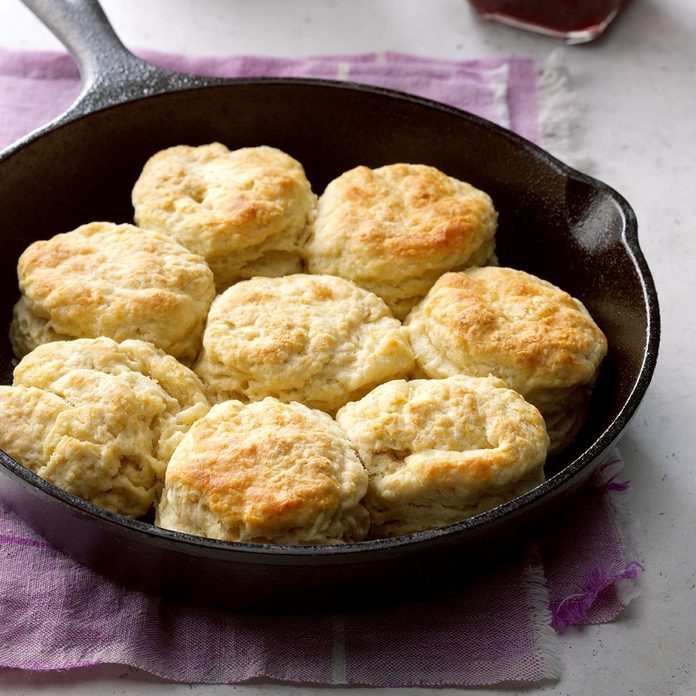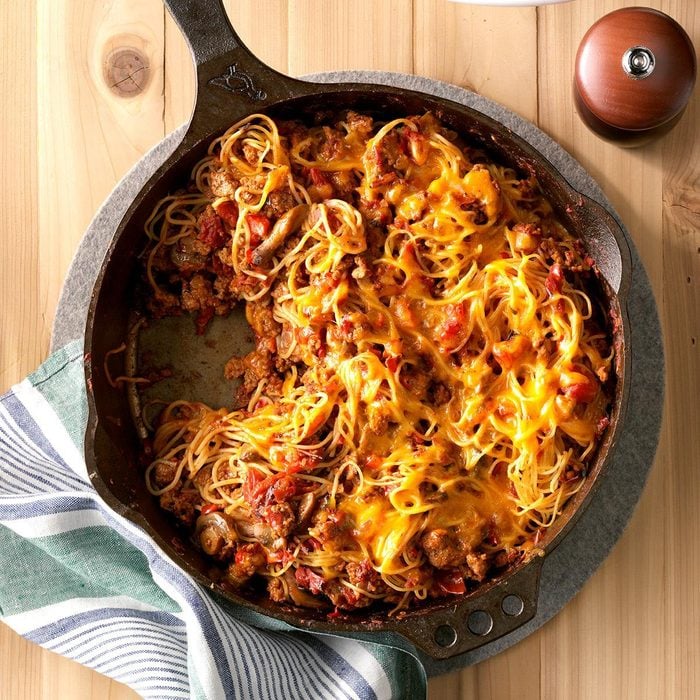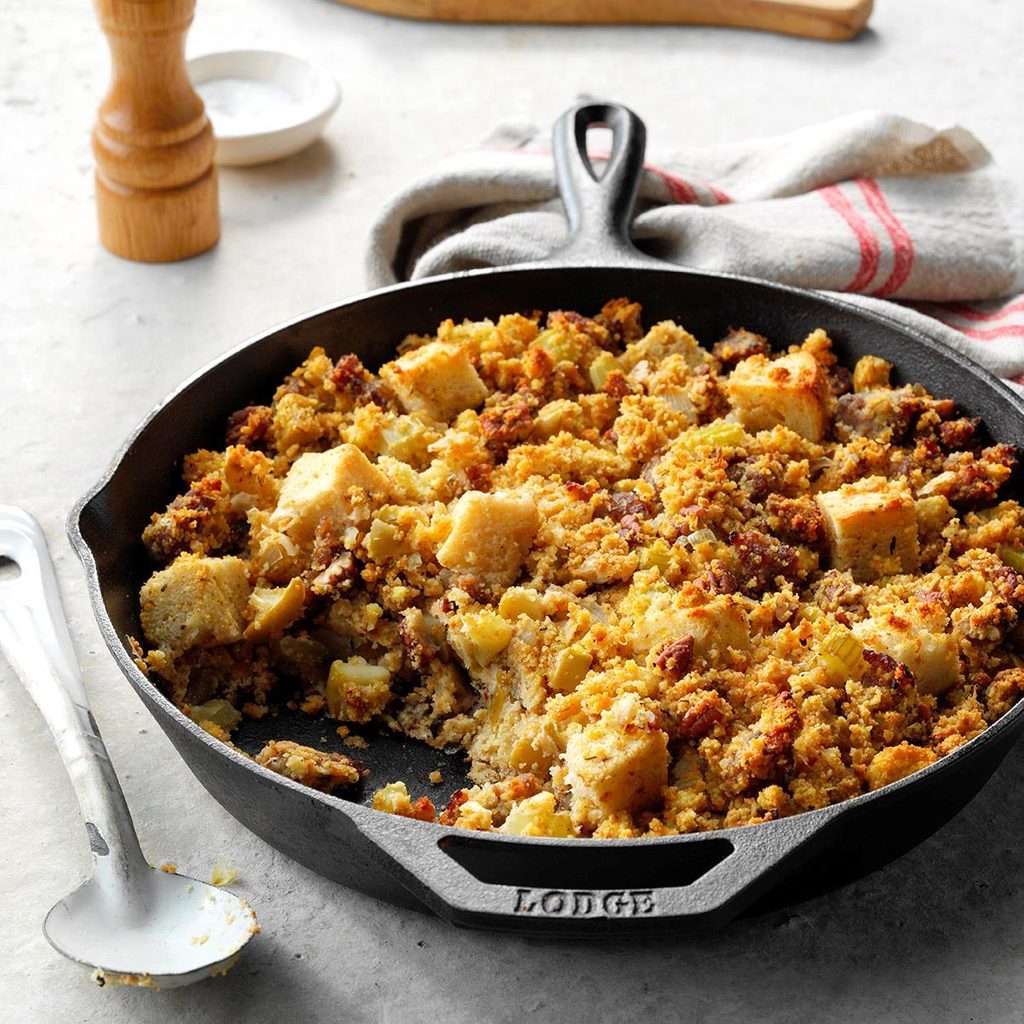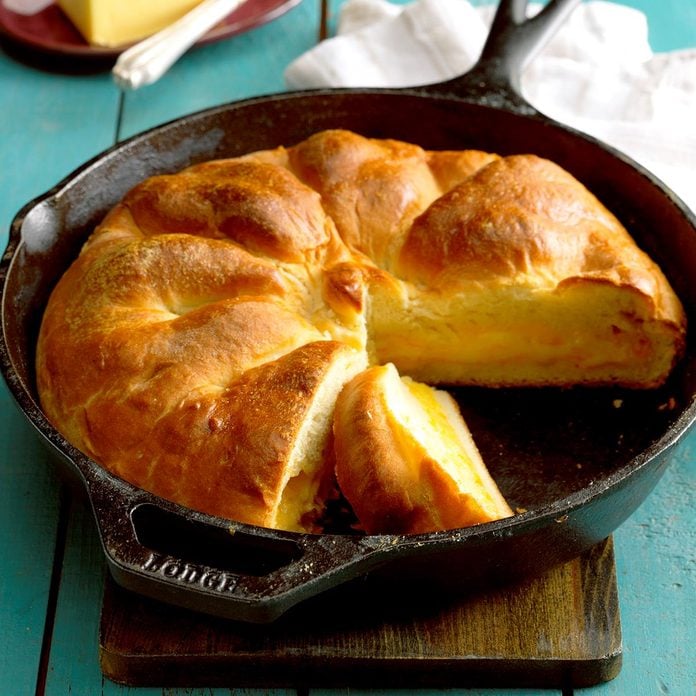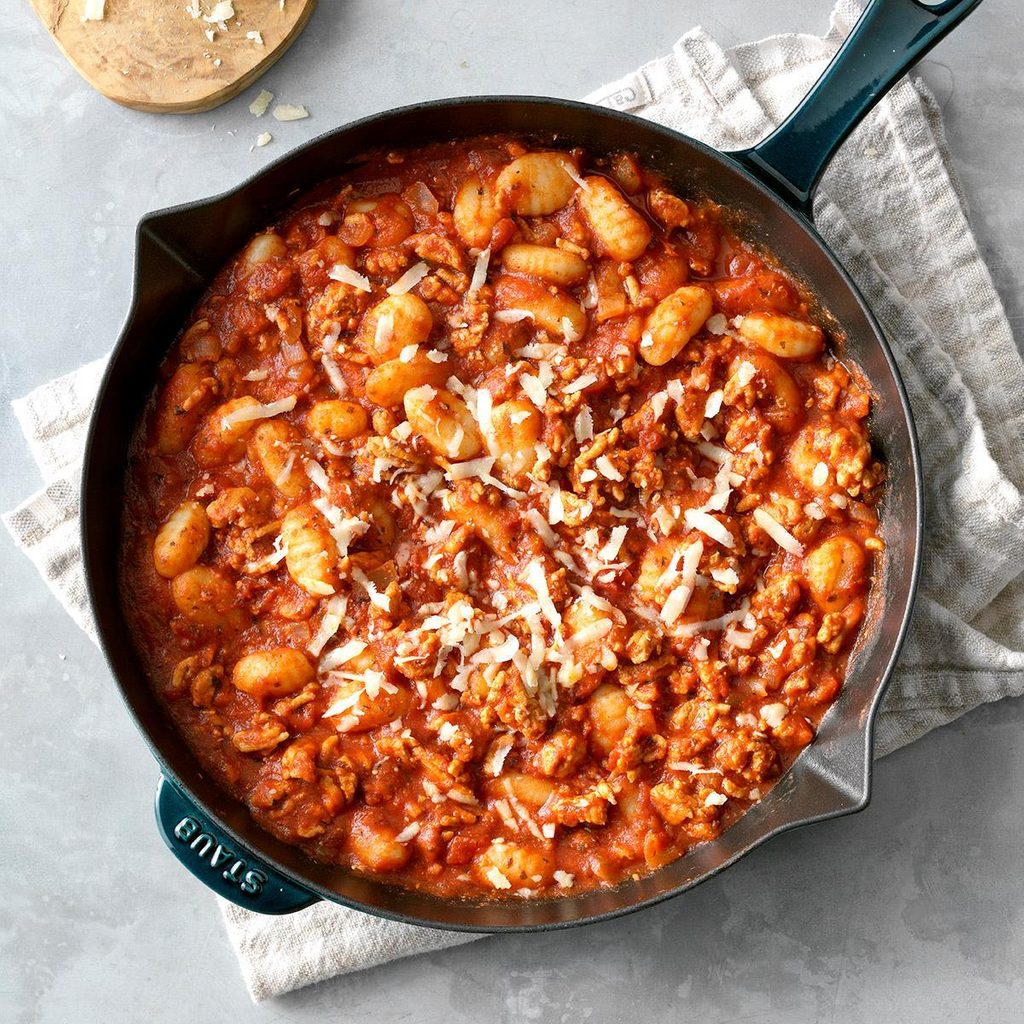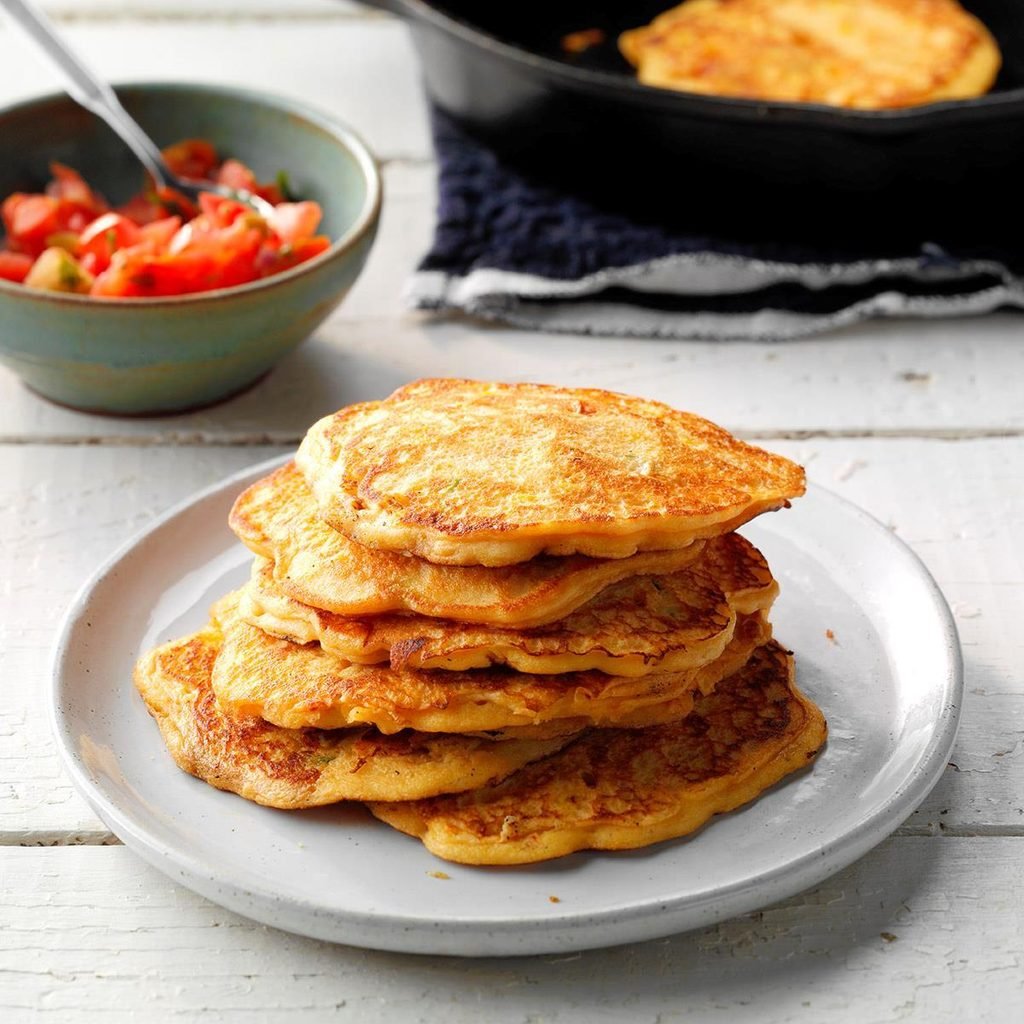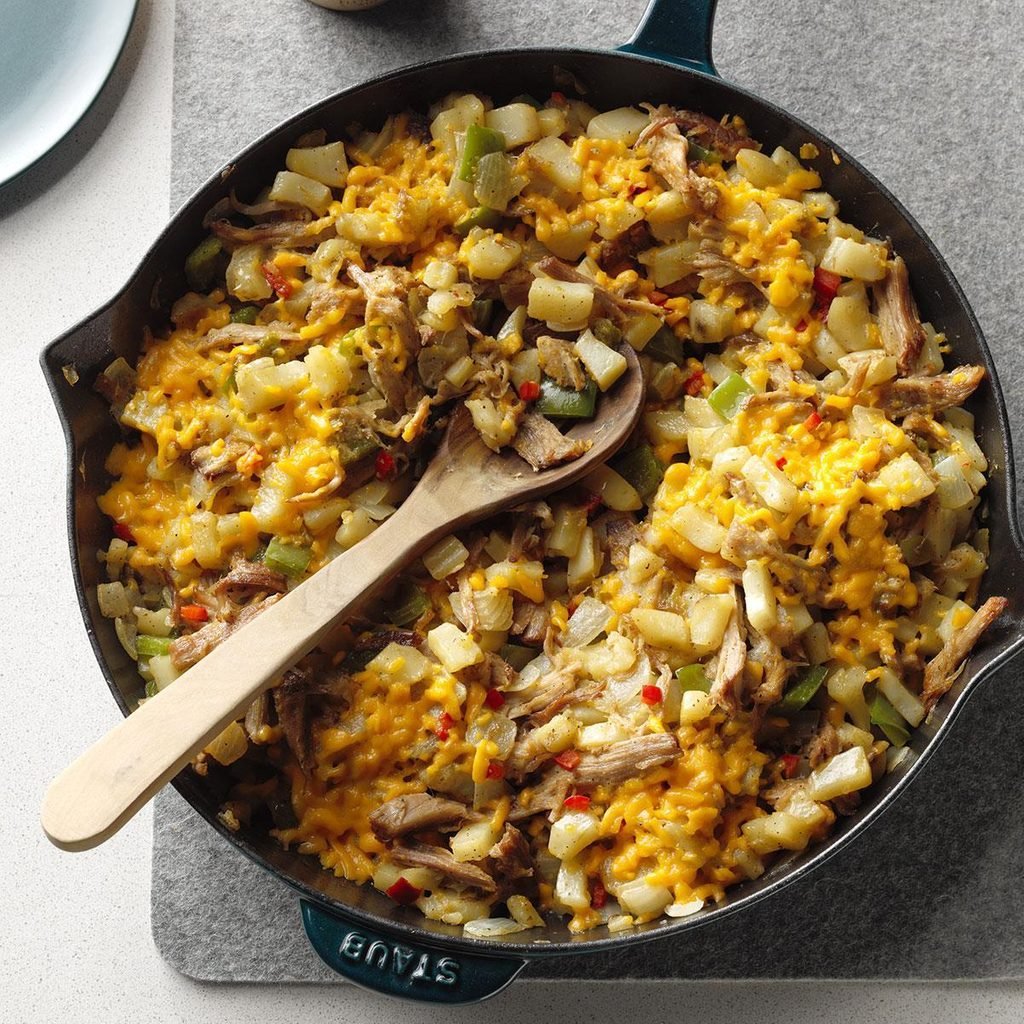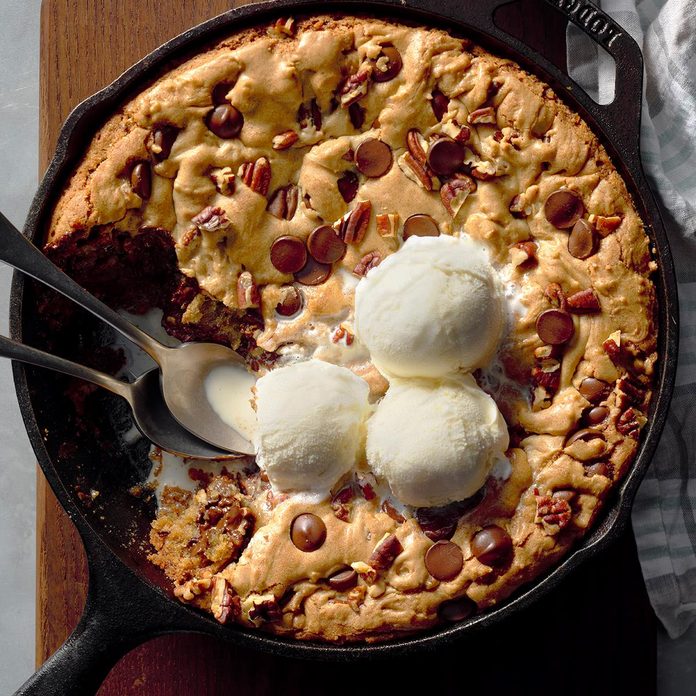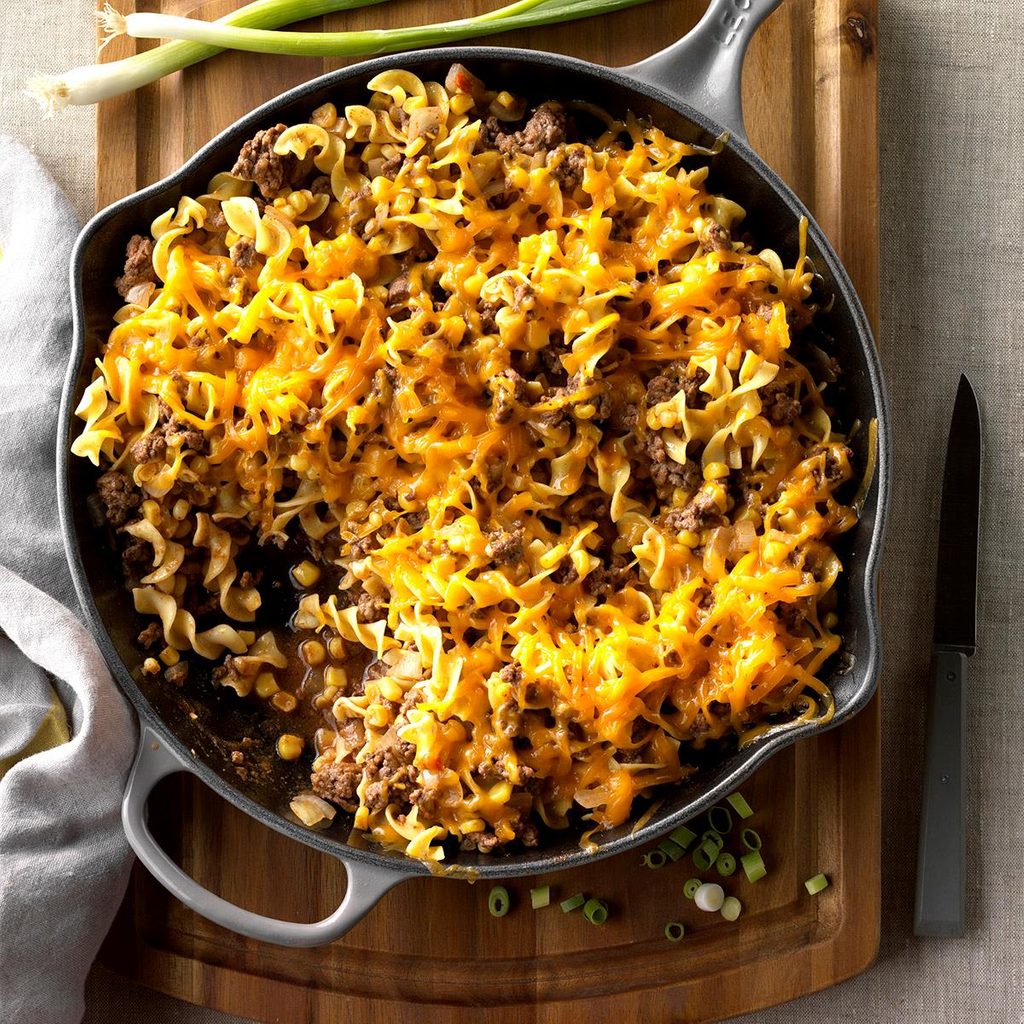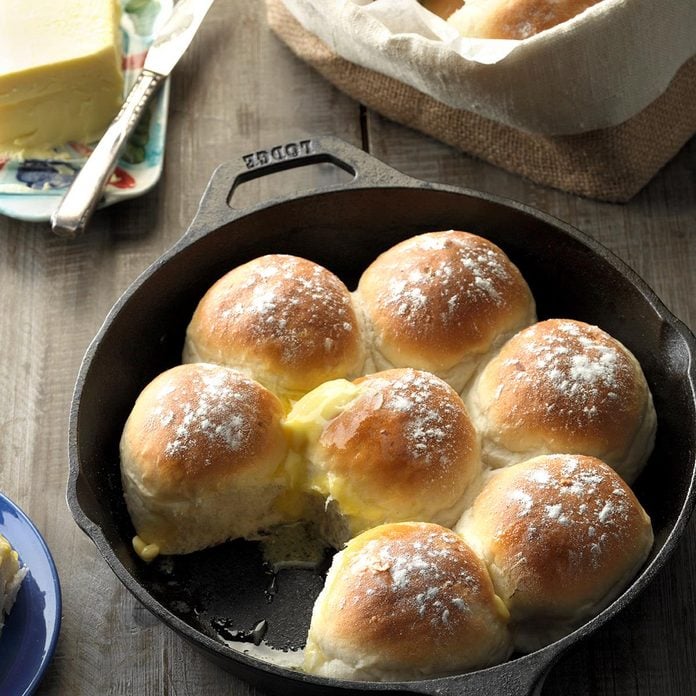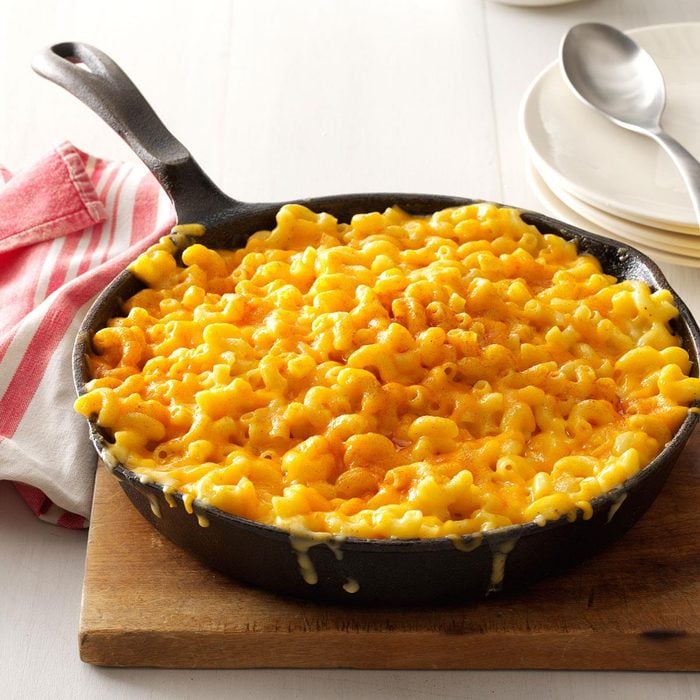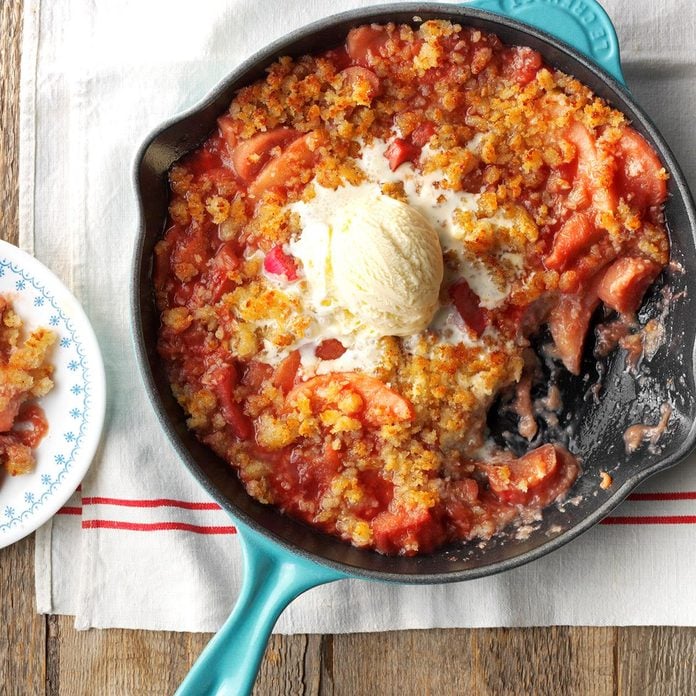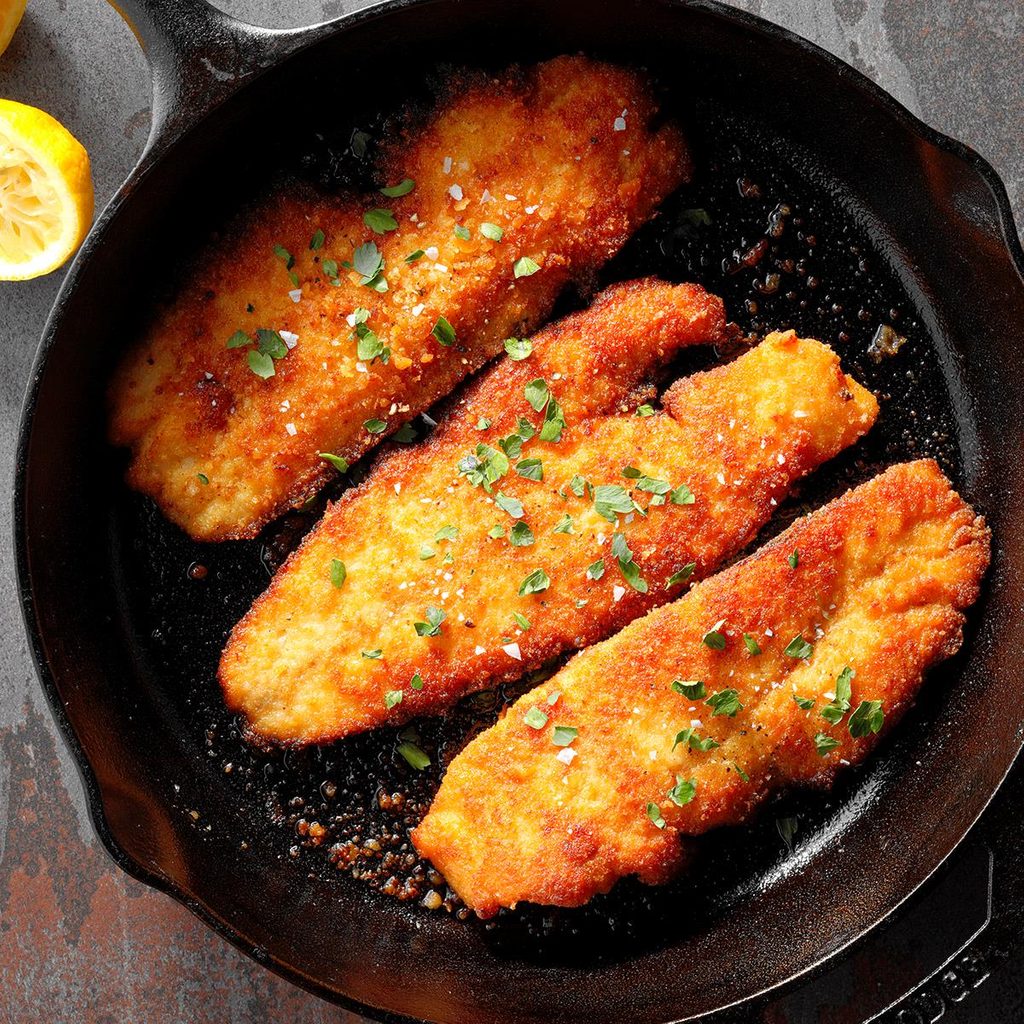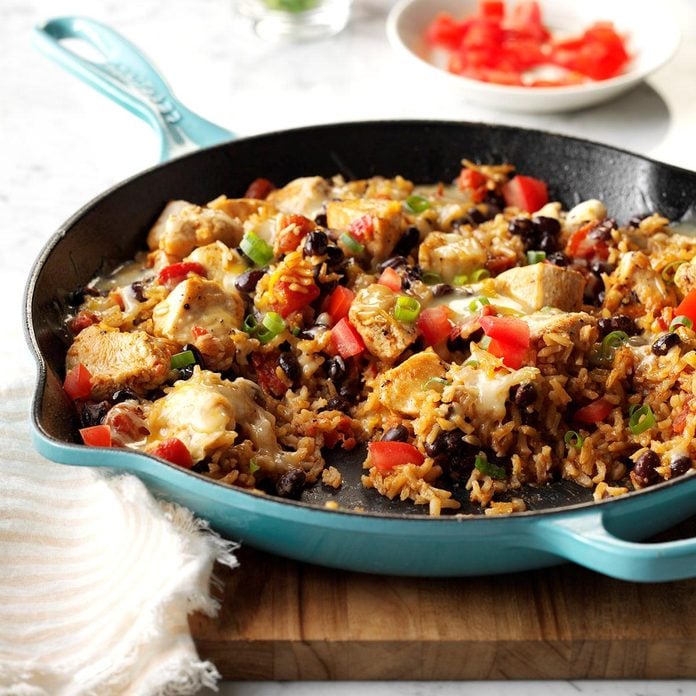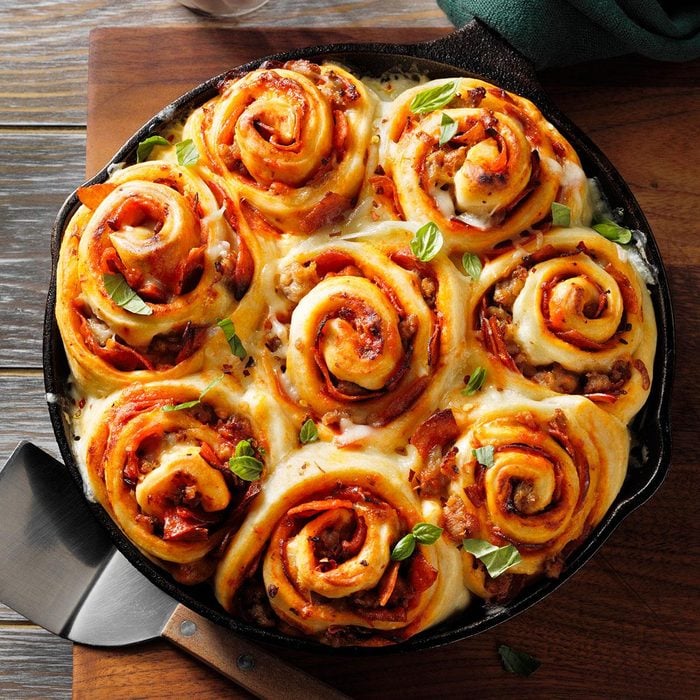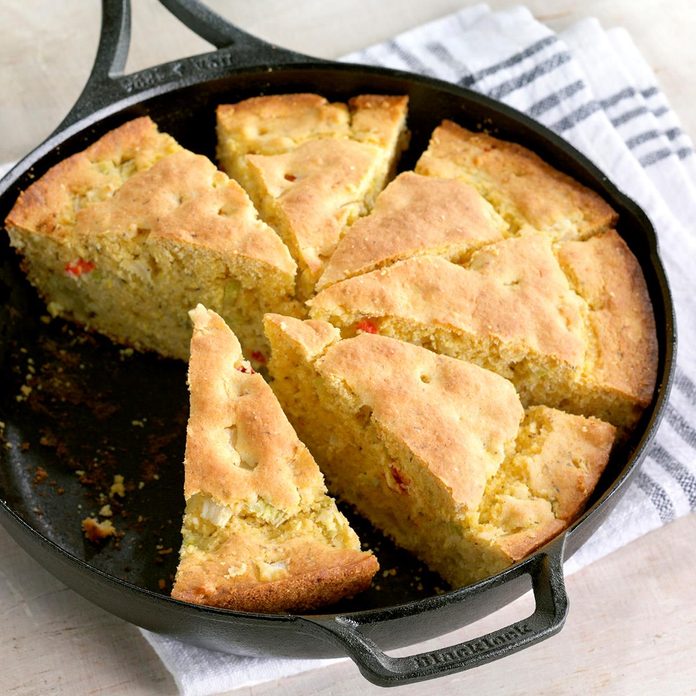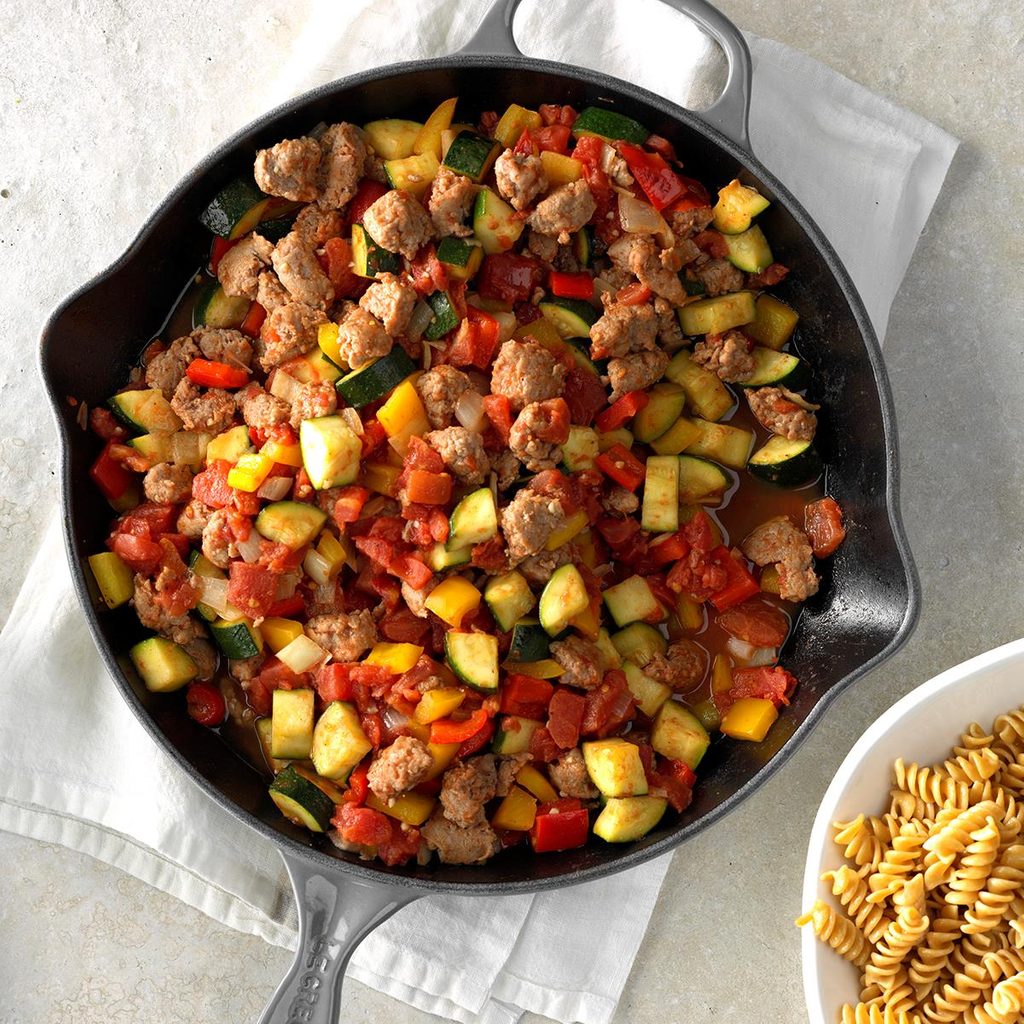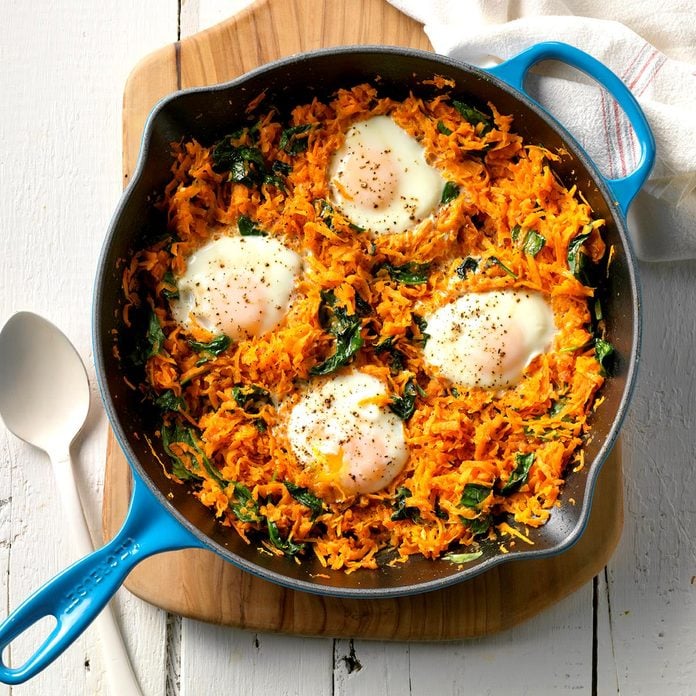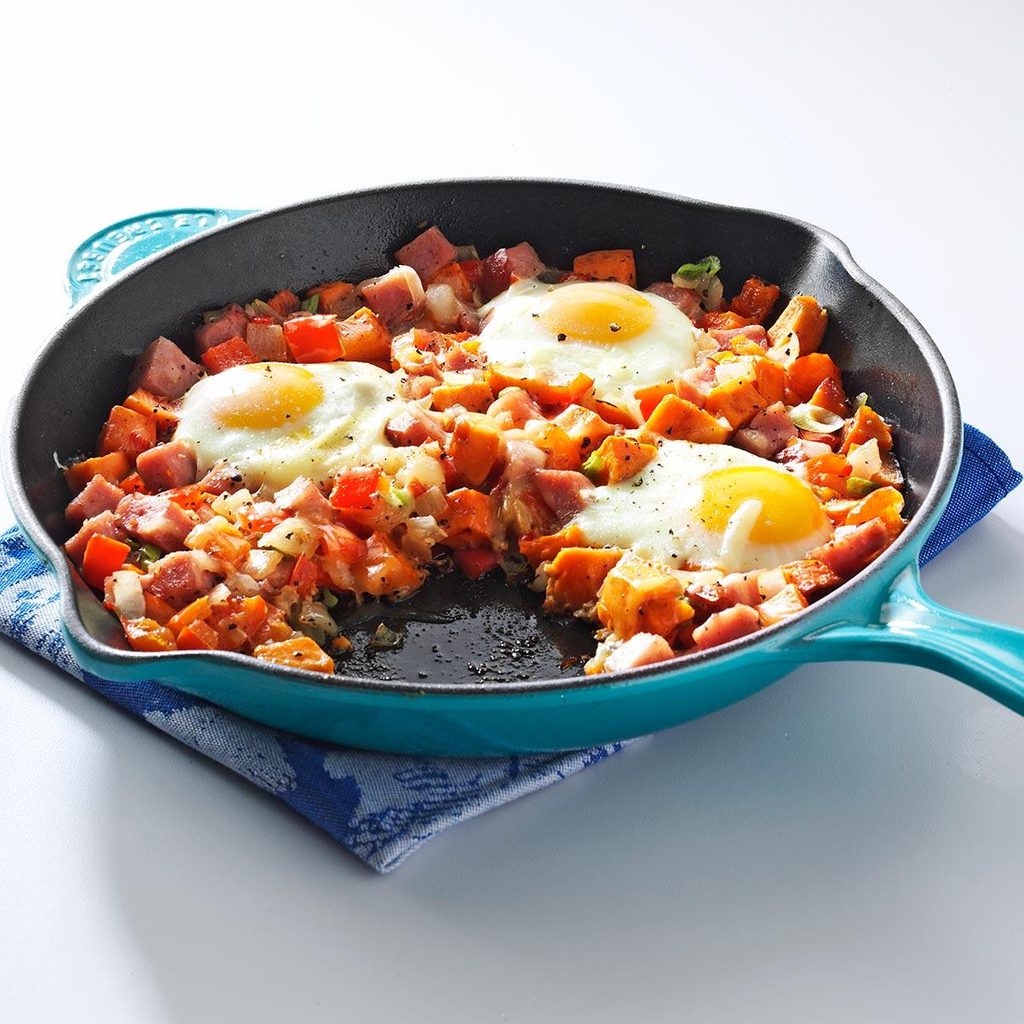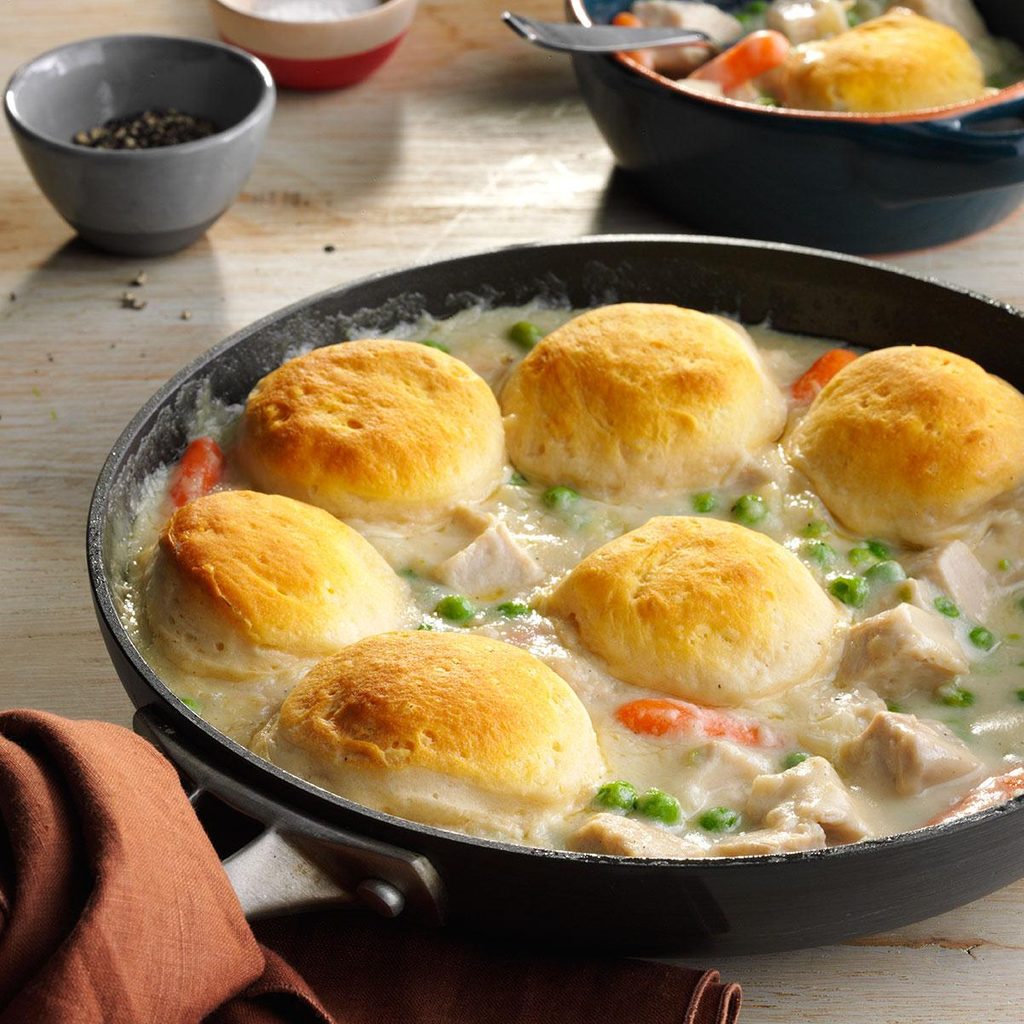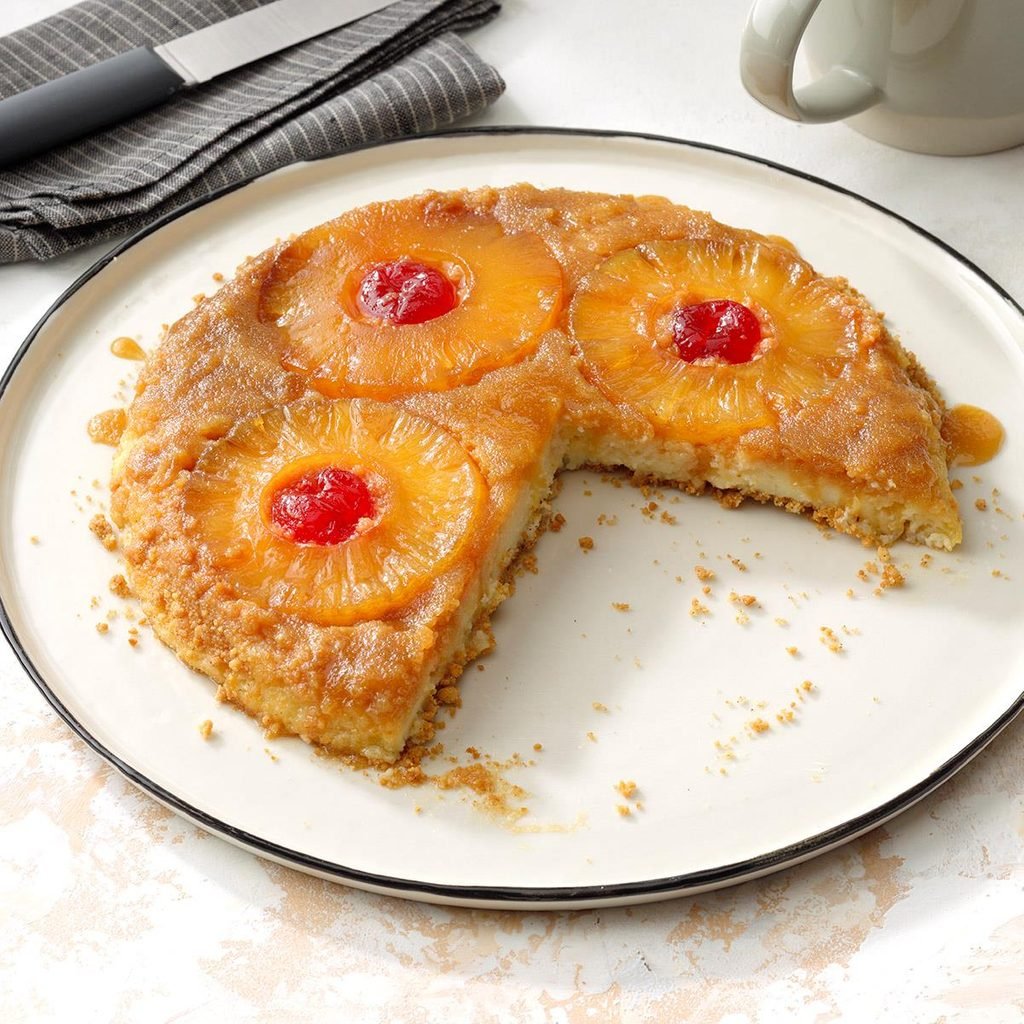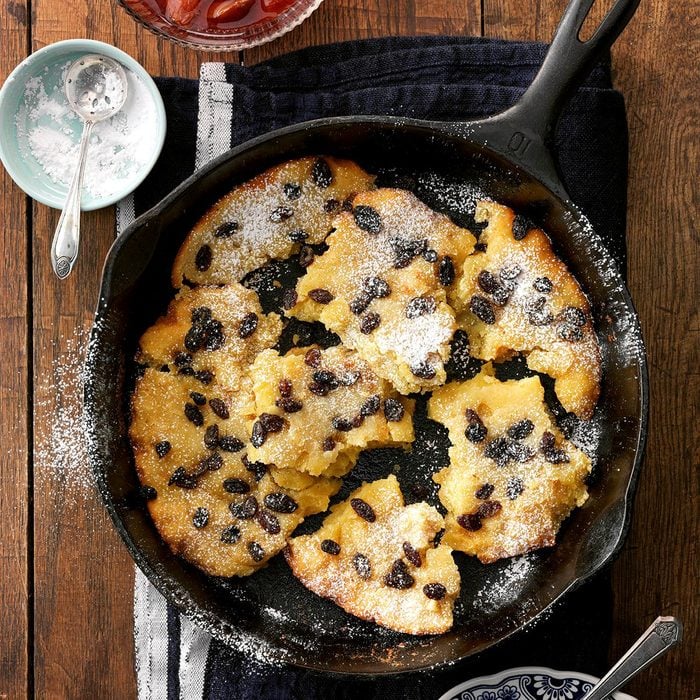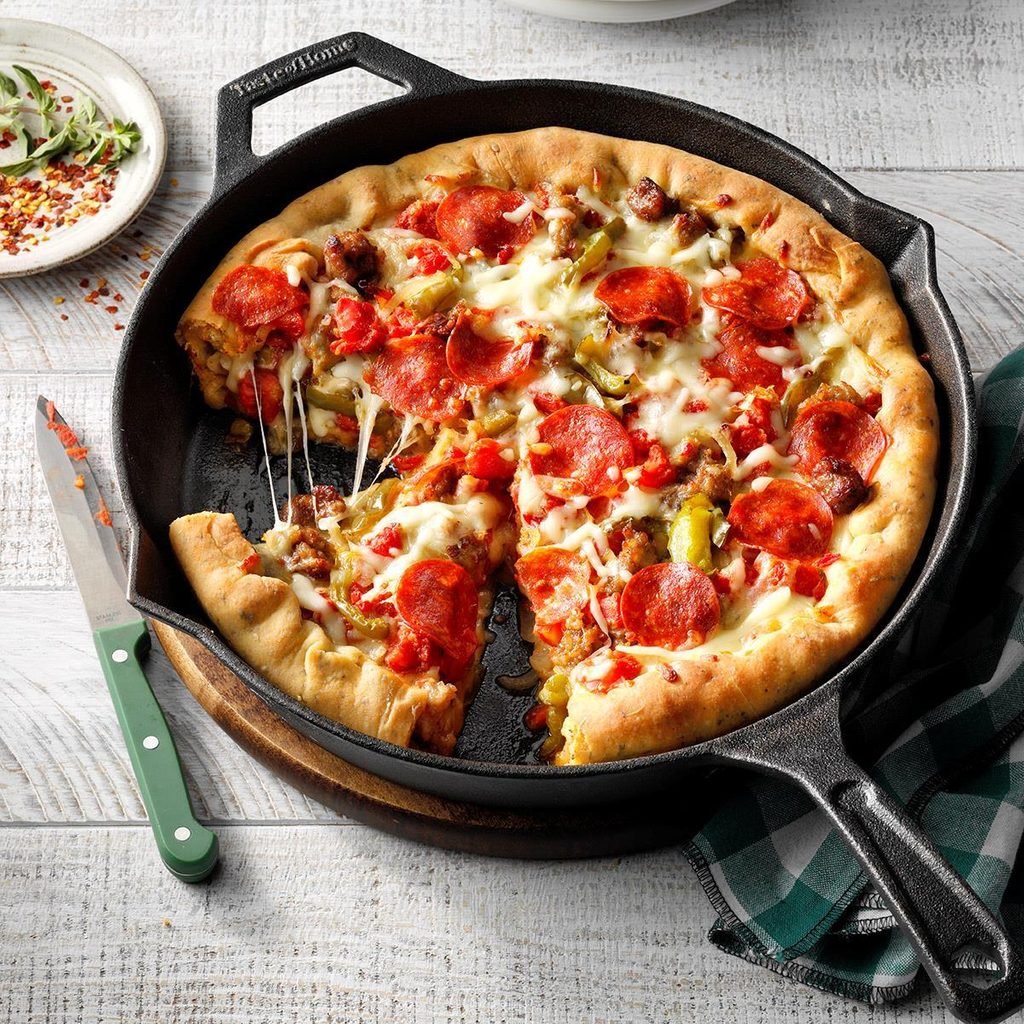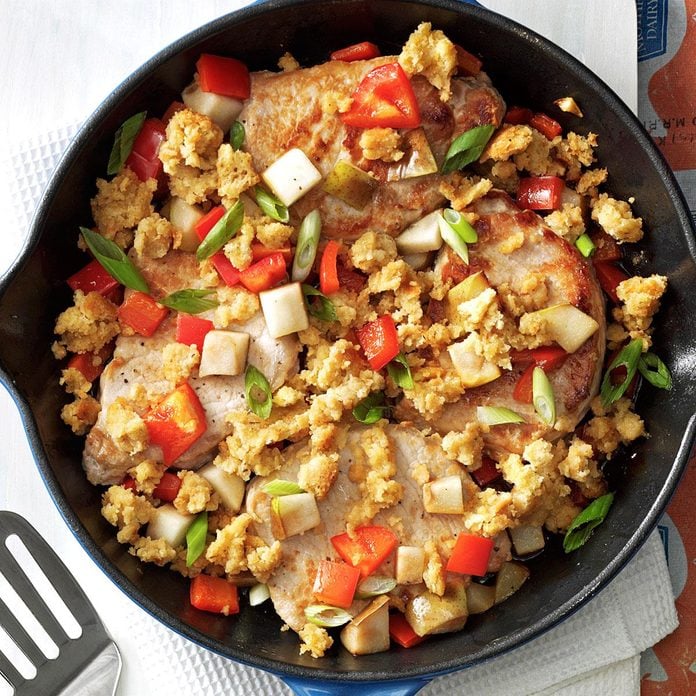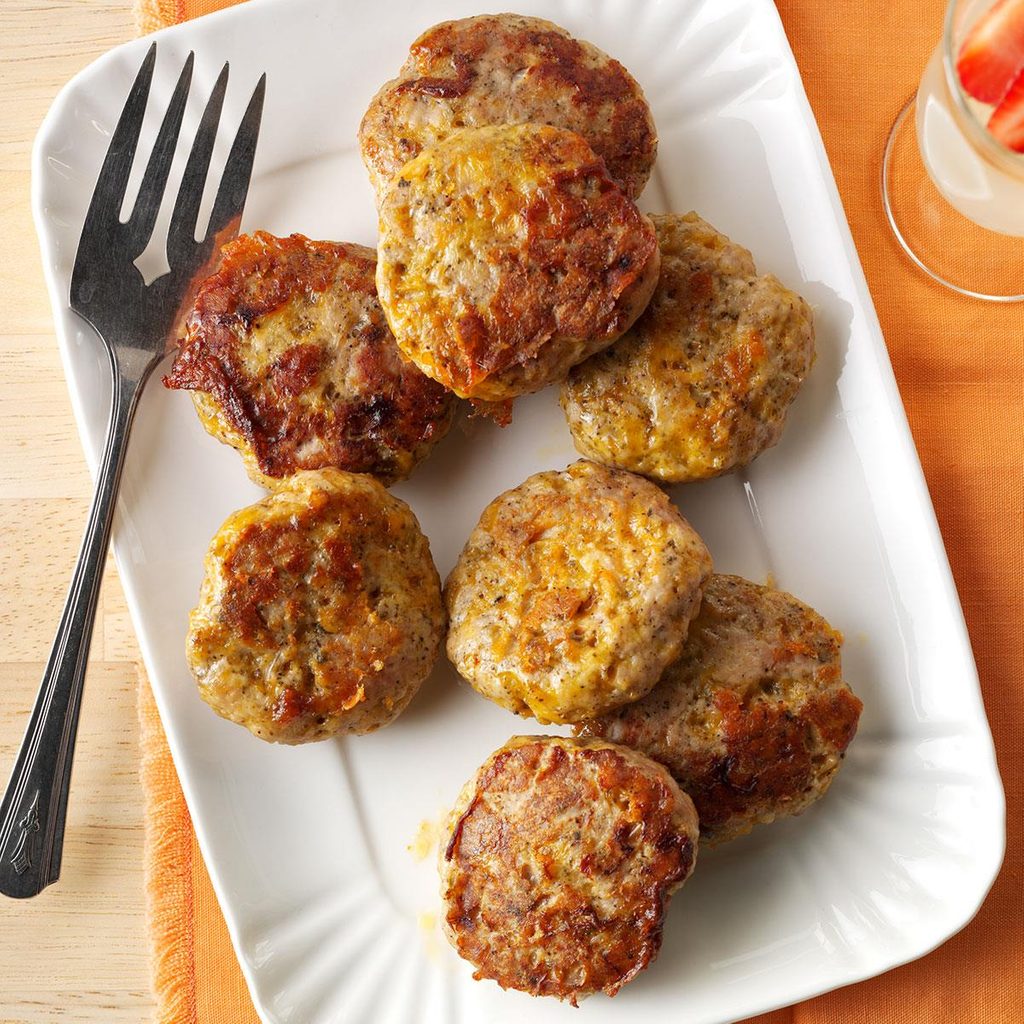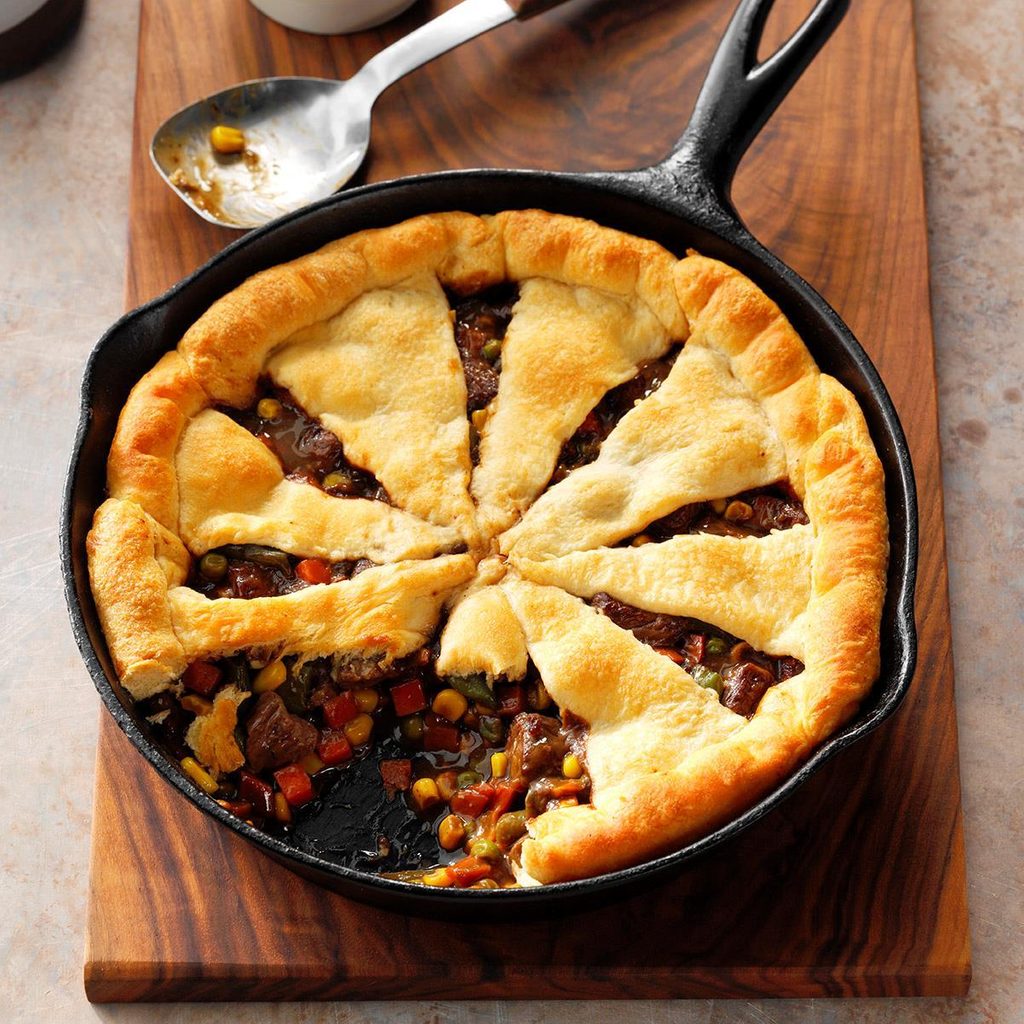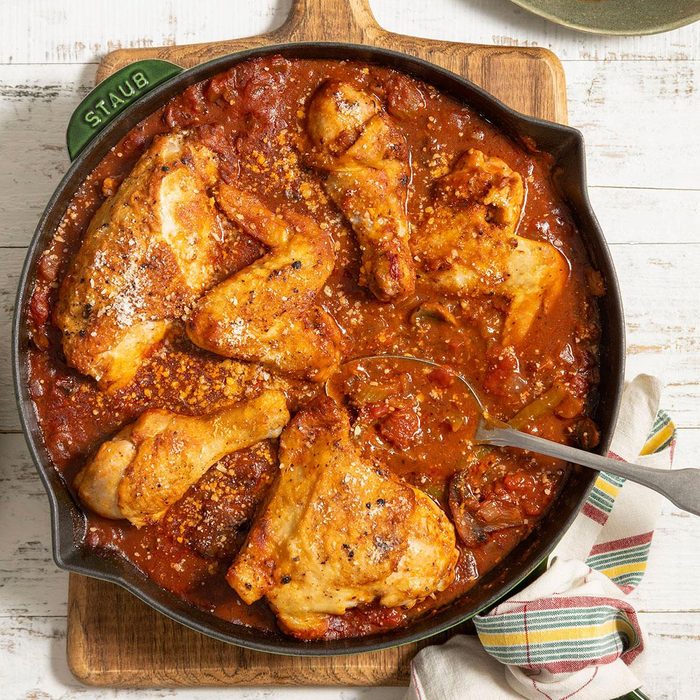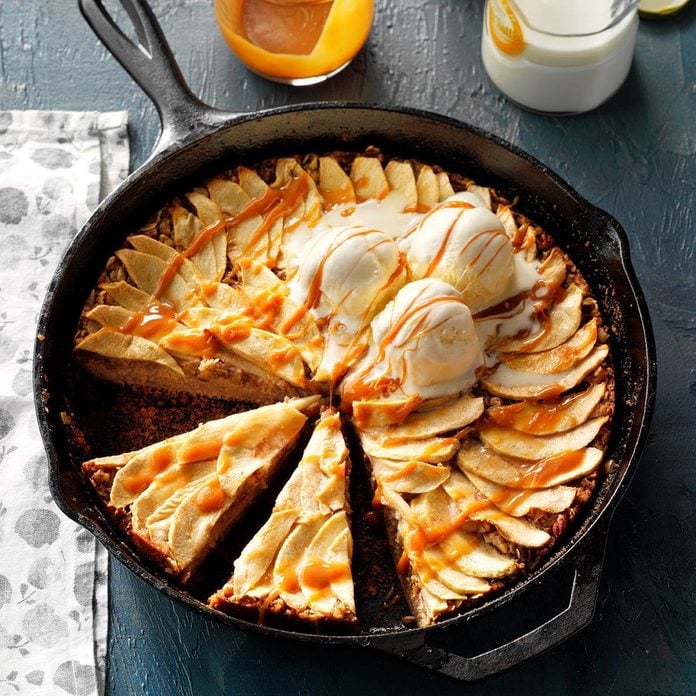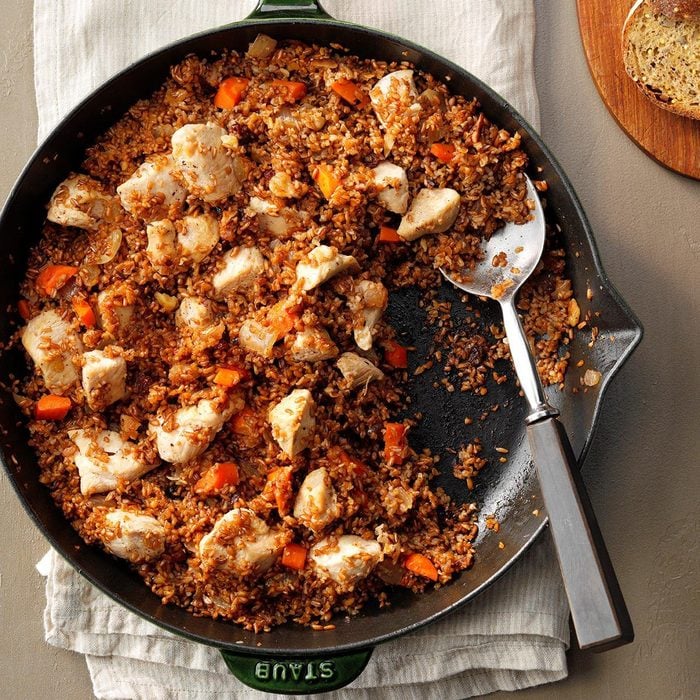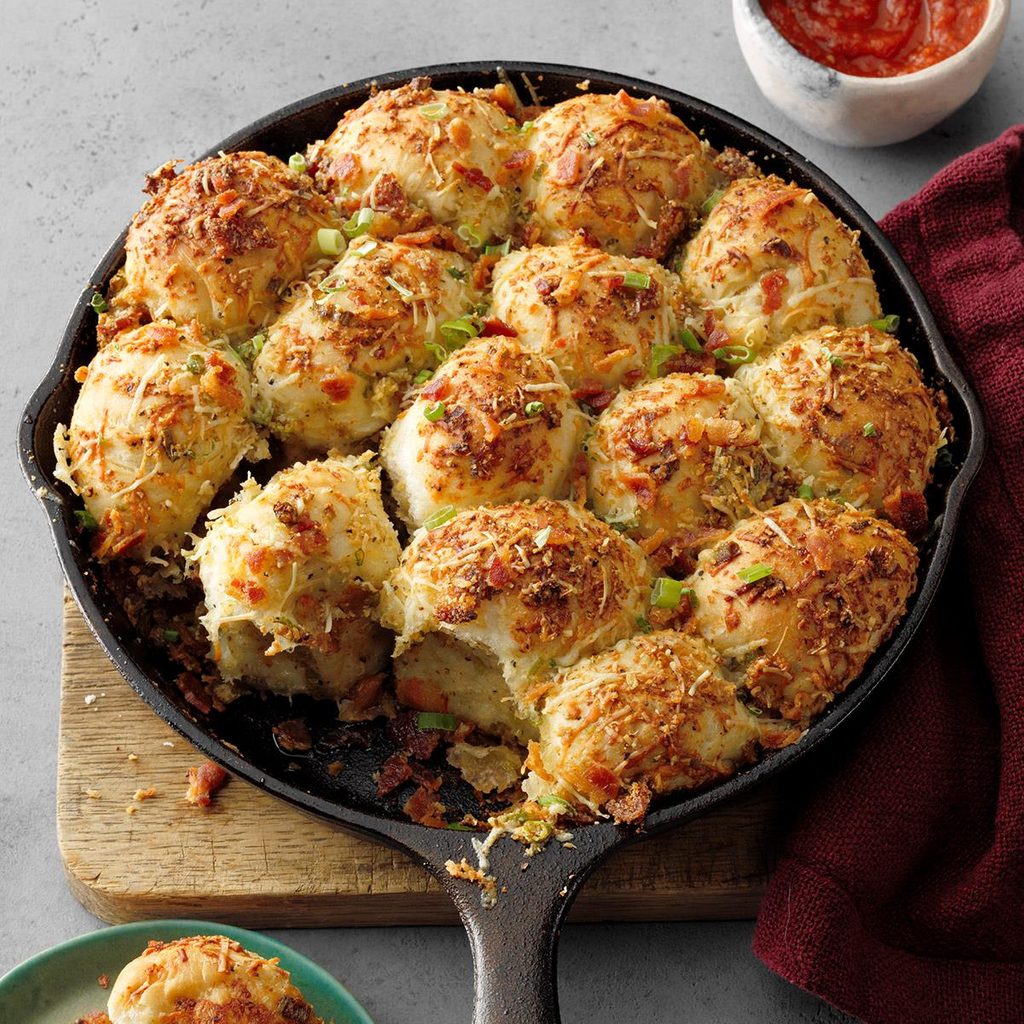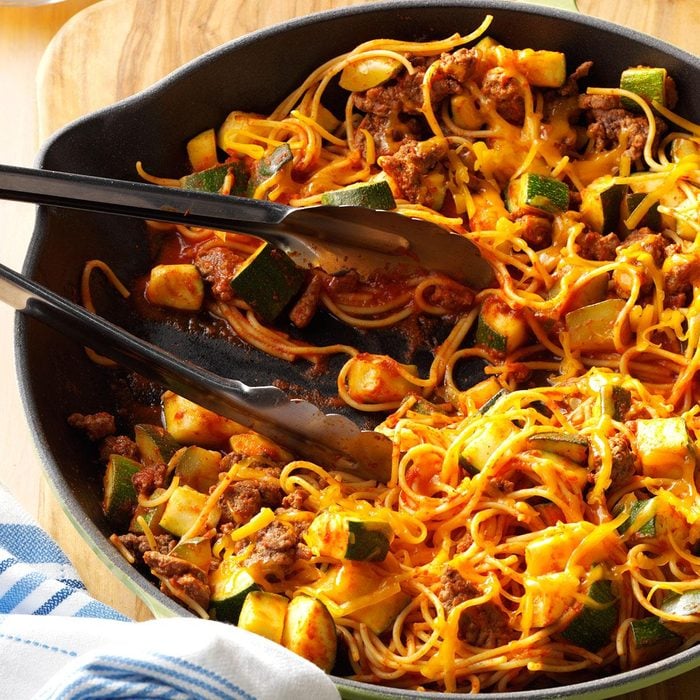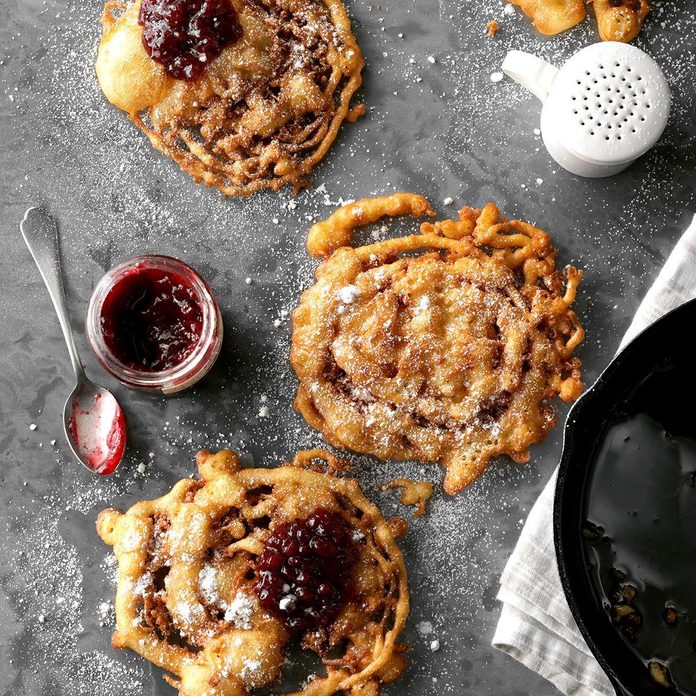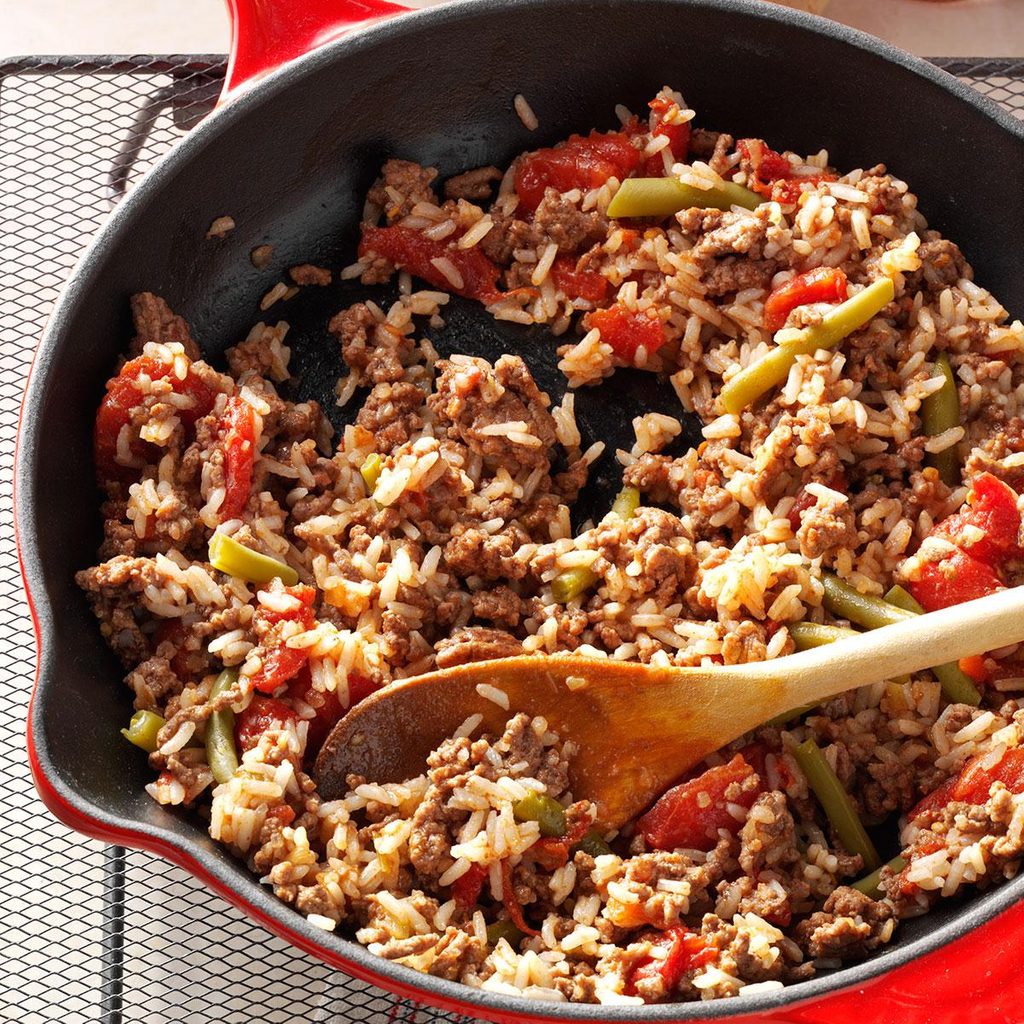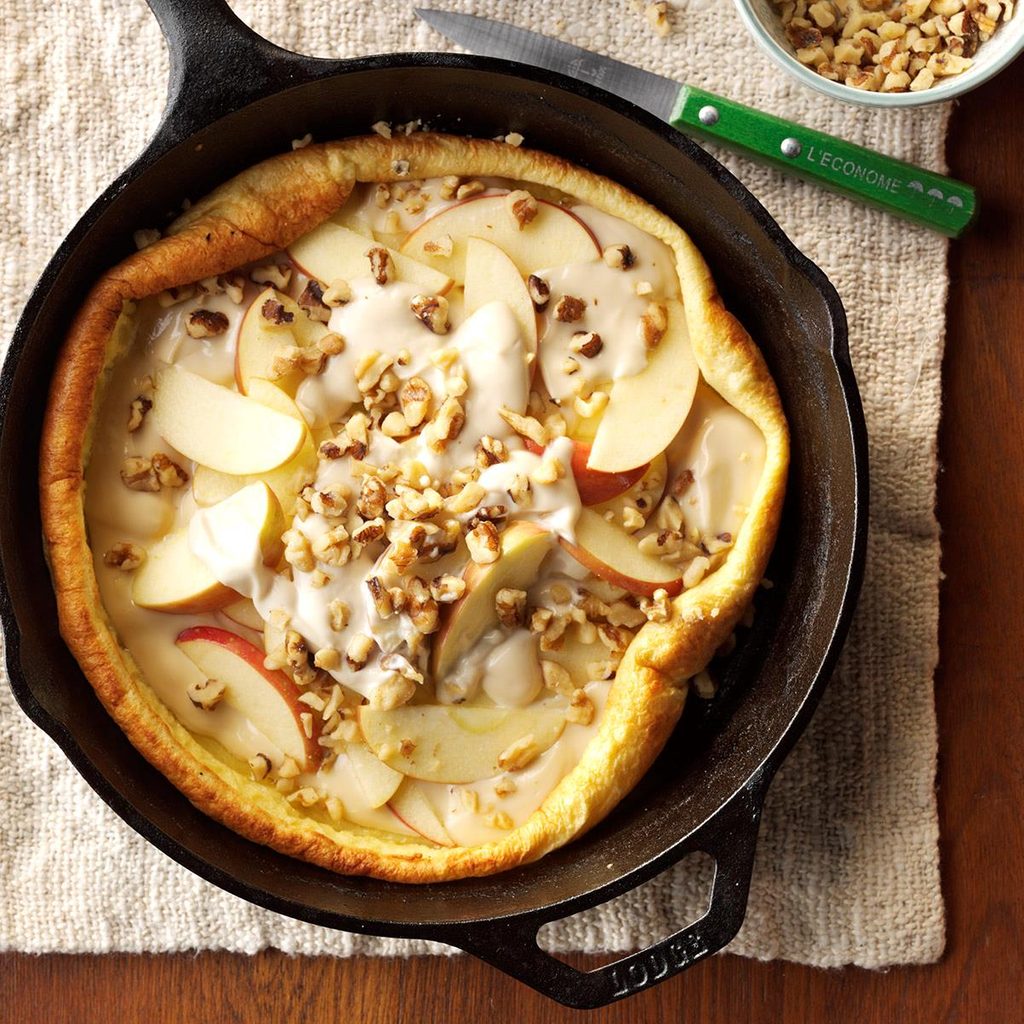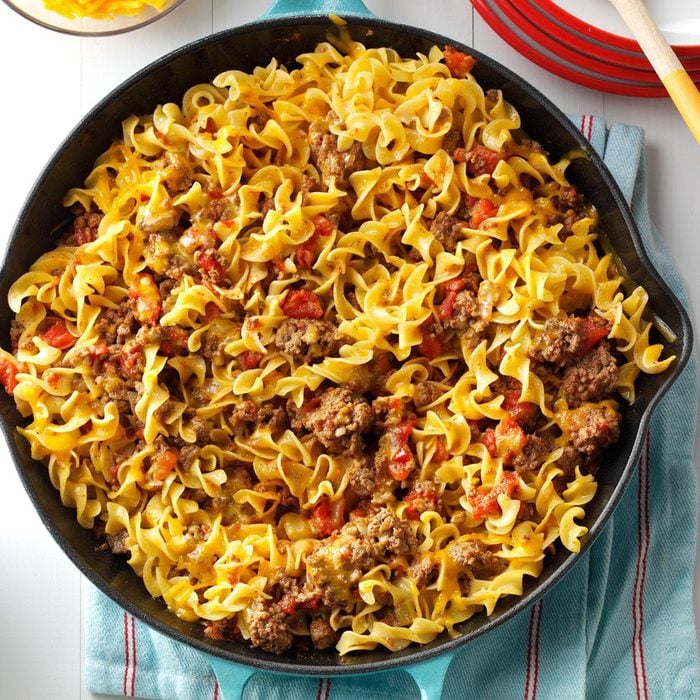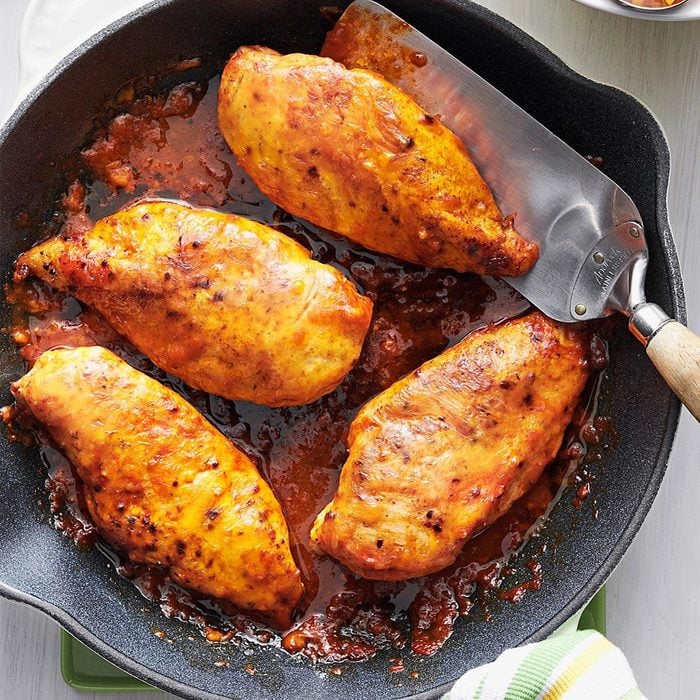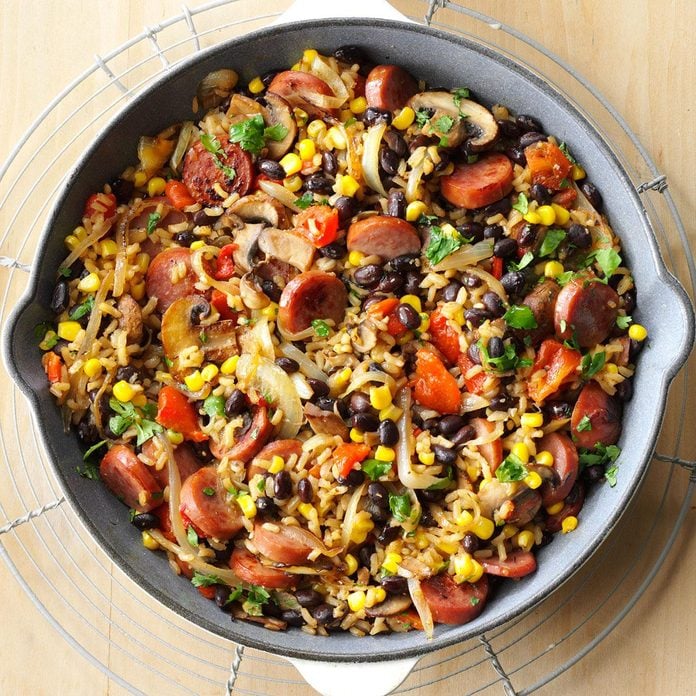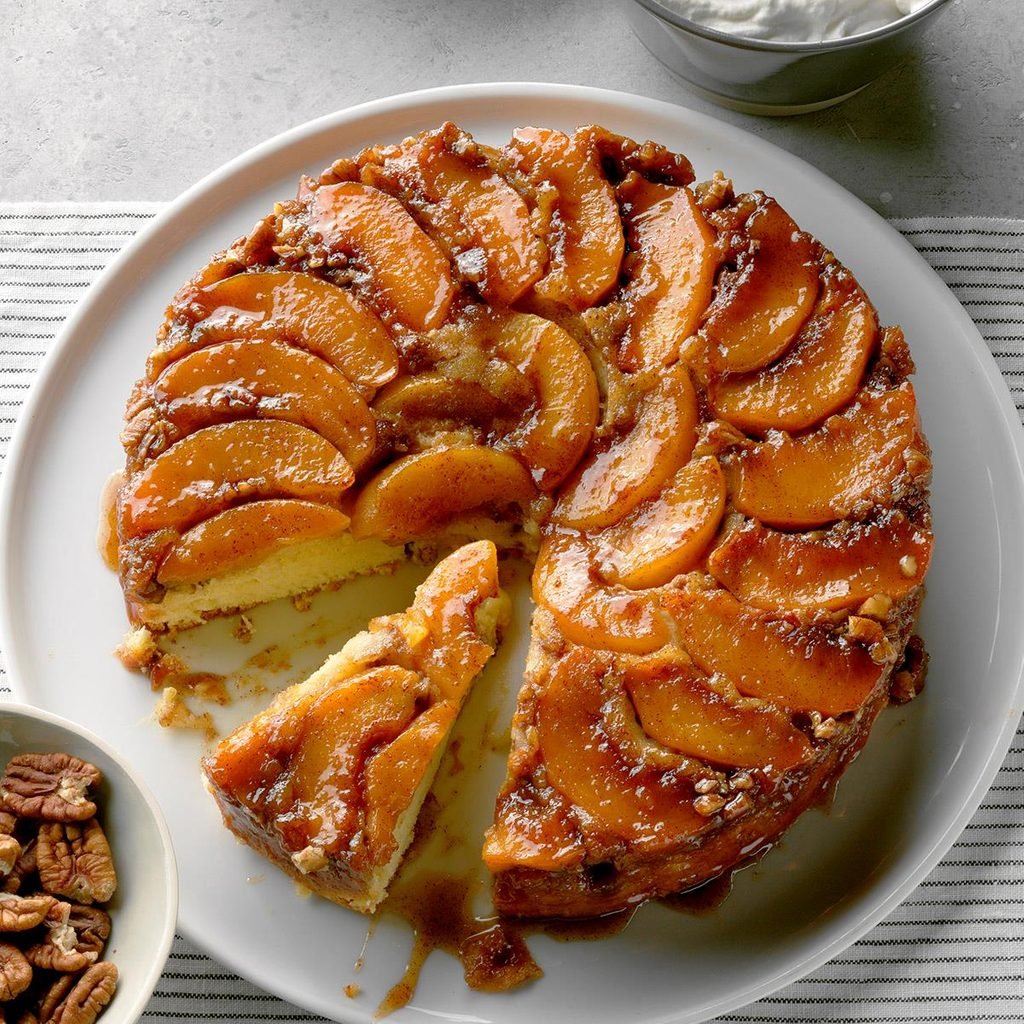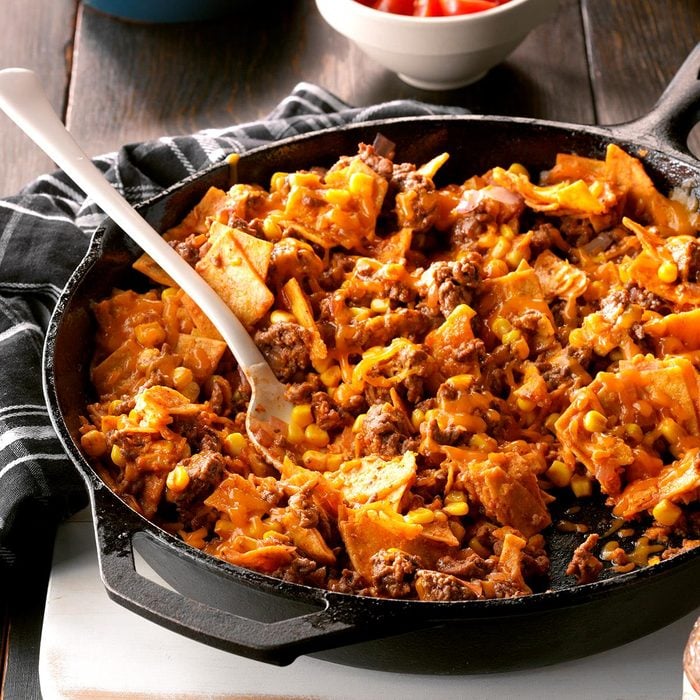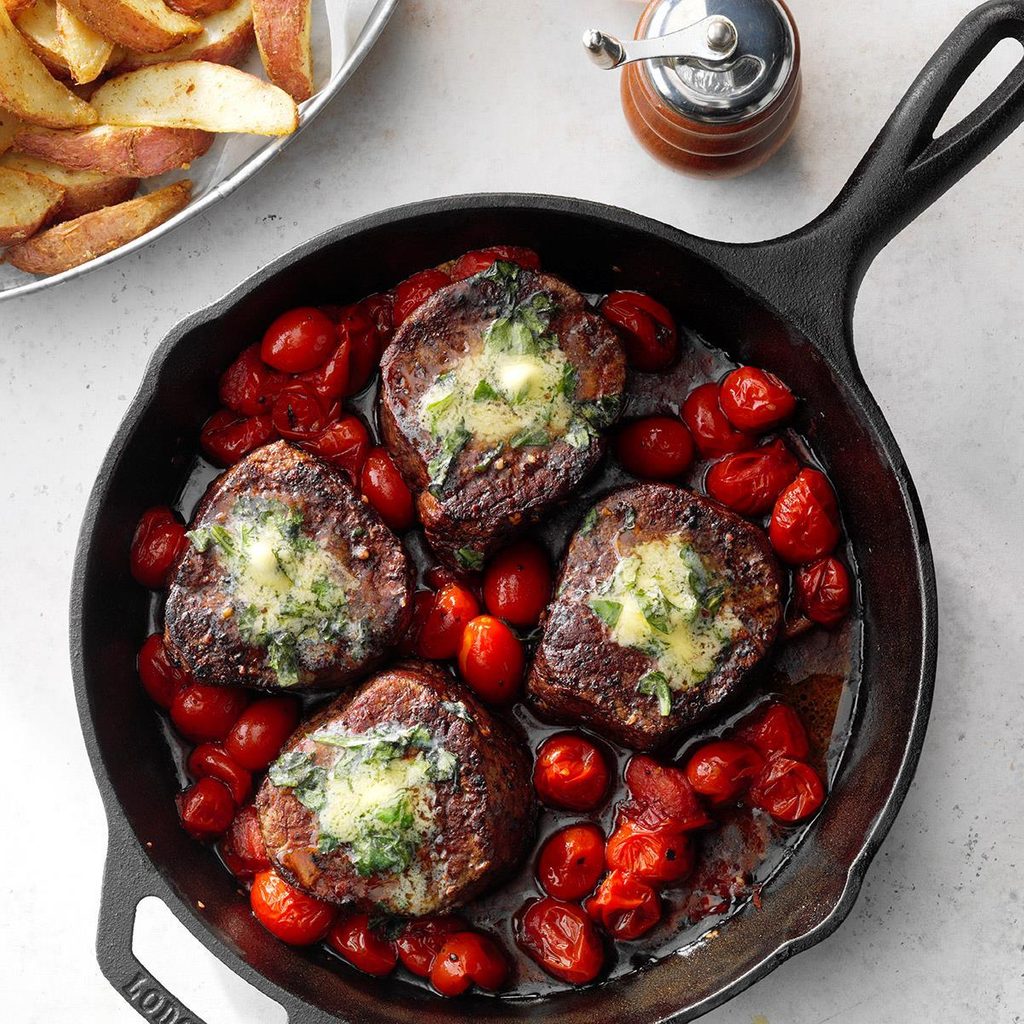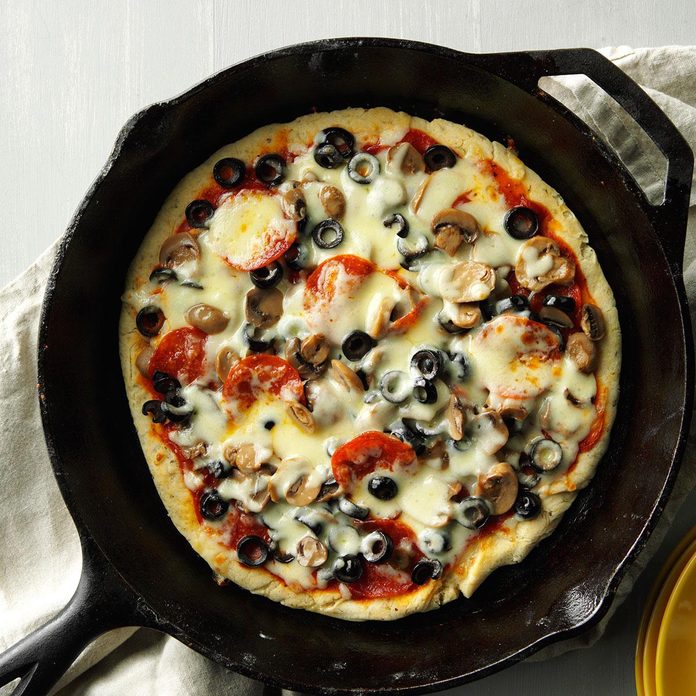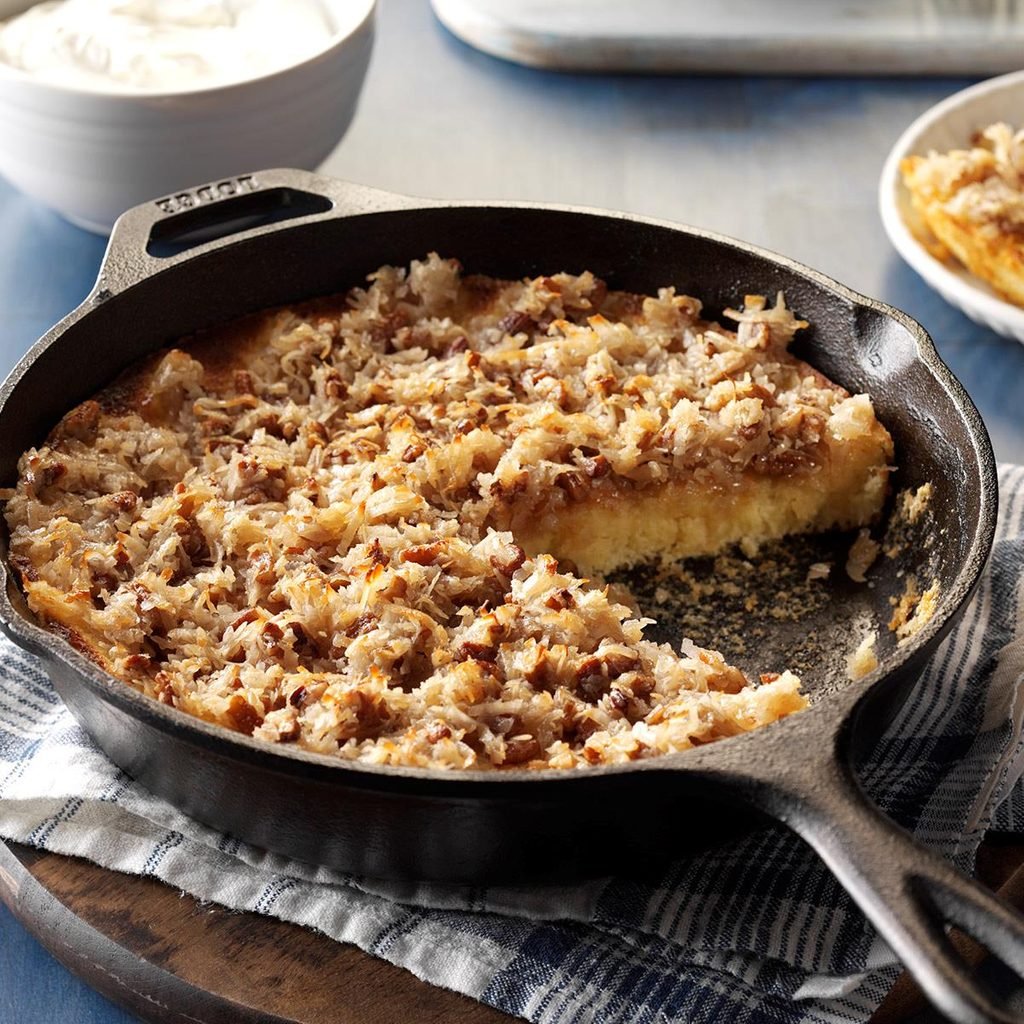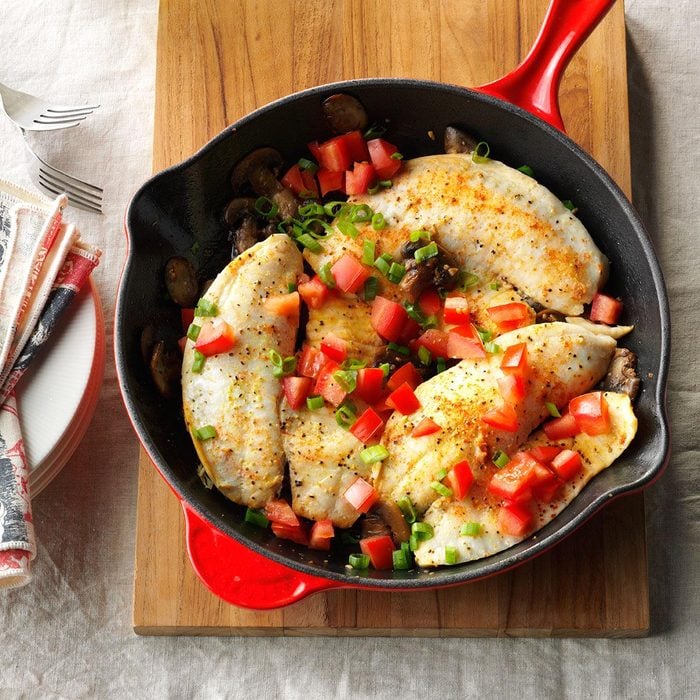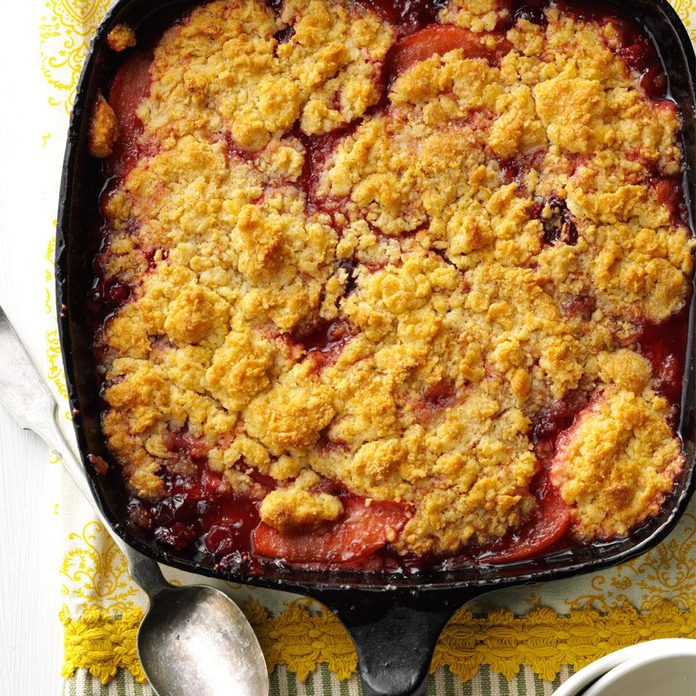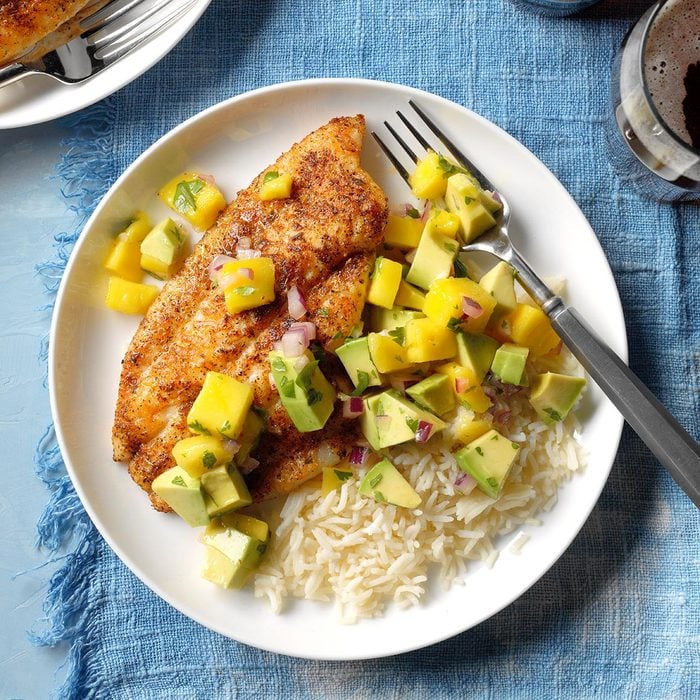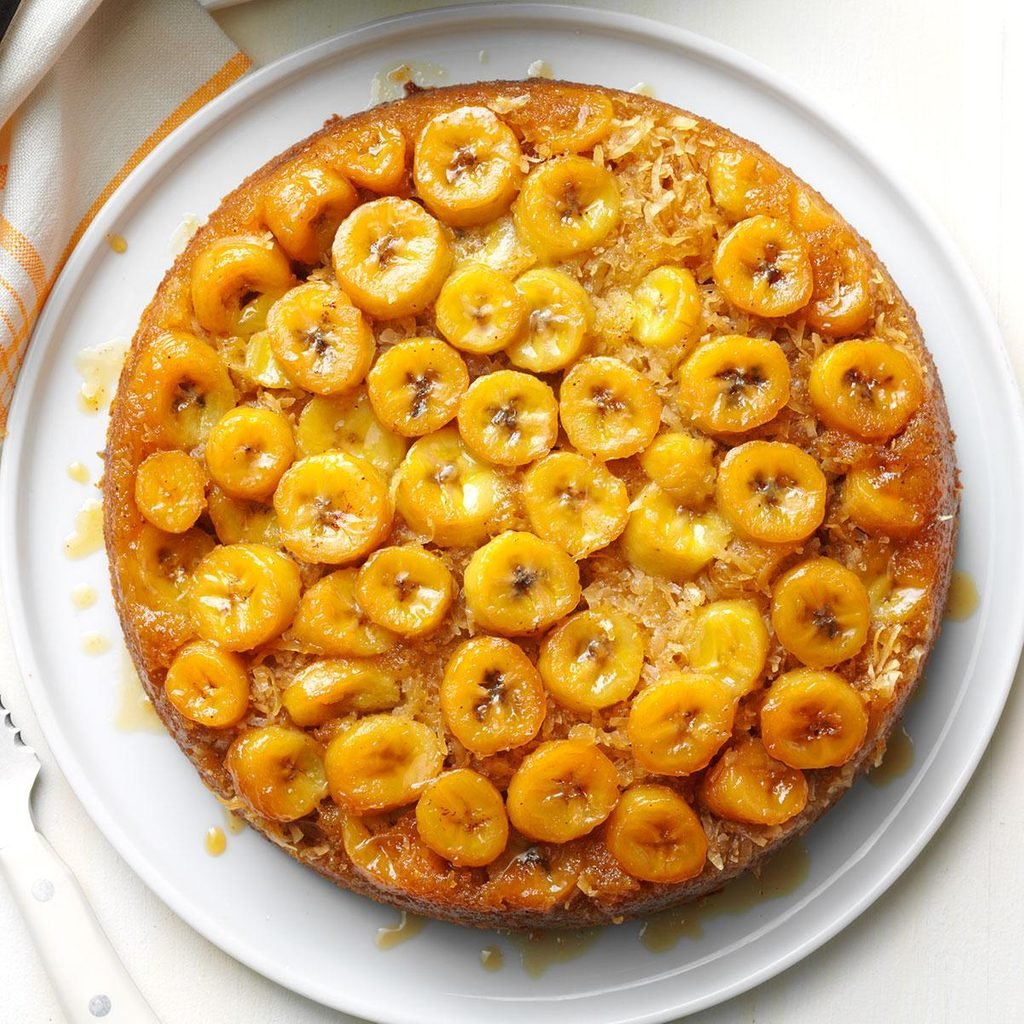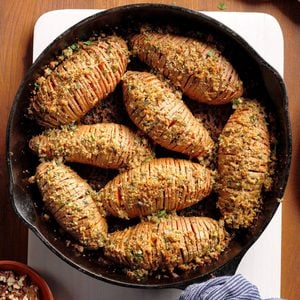 Taste of Home
Taste of Home
Treat your sweet-salty tooth! Sweet potatoes dressed with buttery, herby, garlicky goodness make for a stunning, delicious side dish. —Lauren Knoelke, Milwaukee, Wisconsin
Get Recipe
Rolled Buttermilk BiscuitsI scribbled down this recipe when our family visited The Farmers' Museum in Cooperstown, New York, many years ago. I must have gotten it right, because these biscuits turn out wonderful every time. —Patricia Kile, Elizabeth, Pennsylvania
One-Skillet PastaThis recipe was given to me 25 years ago and remains a family favorite. It's a tasty twist on traditional spaghetti, and making a one-skillet pasta saves time on prep and cleanup, too. —Susan Spence, Lawrenceville, Virginia
Deluxe Cornbread StuffingWhen my husband and I were newlyweds and far from family, we invited friends over for a traditional Thanksgiving feast. I searched for stuffing recipes and combined the best aspects of several to create this one. Everyone liked it, and I still make it for holidays. —Pamela Rickman, Valdosta, Georgia
Muenster BreadMany years ago my sister and I won blue ribbons in 4-H with this bread. The recipe makes a beautiful golden loaf with cheese peeking out of every slice. —Melanie Mero, Ida, Michigan
Rhubarb CrispMake rhubarb crisp with strawberries in spring and apples in fall to enjoy a simple, year-round dessert.
Gnocchi Chicken SkilletStovetop chicken and gnocchi recipes like this one make for a homey dinner in a hurry. Personalize it with your own favorite sauce and seasonings. —Taste of Home Test Kitchen
Salsa Corn CakesThis recipe is super with fresh or canned corn. I whip up these patties to serve alongside nachos or tacos on hot summer evenings. The salsa is subtle but adds flavor. —Lisa Boettcher, Rosebush, Michigan
Hash Brown Pork SkilletAdd potatoes and veggies to leftover pork tenderloin for an easy, creamy weeknight supper in minutes! —
Taste of Home Test Kitchen
PizookieWhat's better than a chocolate chip cookie? How about a
giant chocolate chip pizookie!
Beef Skillet SupperSometimes I'll make extra of this comforting, noodle-y supper to guarantee leftovers. It's a great take-along dish for work or school. Trim calories from the entree by substituting ground turkey for the beef and low-fat cheese for the full-fat cheddar. —Tabitha Allen, Cypress, Texas
Skillet Pork ChopsSkillet pork chops are the kind of hearty, comforting, fuss-free meal everyone needs to have in their repertoire. With just a handful of ingredients and one pan to clean up, it's an ideal weeknight meal.
Potato Pan RollsMy family loves these rolls and requests them often. They don't take long to make because you use quick-rise yeast. —Connie Storckman, Evanston, Wyoming
German Apple PancakeIf you're looking for a pretty dish to make when having guests for brunch, try this. Everyone I've served it to has enjoyed it—except for one time, that is, when my husband tried to make it following my recipe, which I'd written down incorrectly! If you don't leave out the flour as I did, it'll turn out terrific! —Judi Van Beek, Lynden, Washington
Homey Mac & CheeseI also call this "my grandson's mac and cheese." Zachary has been to Iraq and Afghanistan with both the Marines and Navy, and I've been privileged to make his favorite casserole for him for over 20 years. —Alice Beardsell, Osprey, Florida
Macaroon-Topped Rhubarb CobblerCrumbled macaroons are a surprising addition to this cobbler’s topping. We love that you can make the sweet treat in a baking dish or a cast-iron skillet.
—Taste of Home Test Kitchen
Honey WalleyeMy state is known as the Land of 10,000 Lakes, so fishing is a favorite recreational activity here. This recipe is a quick way to prepare all the fresh walleye hooked by the anglers in my family. —Kitty McCue, St. Louis Park, Minnesota
Chicken Burrito SkilletWe love Mexican night at our house, and I love to re-create dishes from our favorite restaurants. This burrito-inspired dish is ready for the table in almost no time! —Krista Marshall, Fort Wayne, Indiana
Pizza RollsThis cheesy, pepperoni-studded pizza rolls recipe is so much fun to make! Serve the handheld snacks with warm marinara as a party appetizer, or pair each roll with a side salad for pizza night with the family.
Skillet Herb BreadWe had a lot of family get-togethers while I was growing up. My grandmother, aunts and mom were all good cooks, and each had her own specialty when it came to bread. Mom's was my favorite—she created this recipe more than 40 years ago. The flavors call to mind the taste of cornbread stuffing! —Shirley Smith, Yorba Linda, California
Eggs and PotatoesLoaded with tender potatoes, semi-runny eggs and gooey cheese, this skillet eggs and potatoes recipe captures the perfect combination of flavors and textures. This recipe uses a single skillet to whip up a hearty meal in only 30 minutes.
Italian Sausage Veggie SkilletWe love Italian sausage sandwiches, but because the bread isn't diet-friendly for me, I created this recipe to satisfy my craving. If you like some heat, use hot peppers in place of the sweet peppers. —Tina Howells, Salem, Ohio
Sweet Potato and Egg SkilletI try to incorporate nutritious sweet potatoes in meals as often as possible, especially with breakfast. I came up with this recipe to feed my family a healthy, hearty breakfast—and it worked! —Jeanne Larson, Rancho Santa Margarita, California
Spicy Veggie Pasta BakeMy dad cooked with cast-iron skillets, so when I do, I remember his amazing culinary skills. I keep the tradition going with my veggie pasta. —Sonya Goergen, Moorhead, Minnesota
Chicken FajitasSizzling chicken fajitas are super easy to make and full of flavor. The secret is in the skillet, which can go from stove to table for restaurant-quality presentation.
Cinnamon-Sugar Apple PieCinnamon apple pie baked in a
cast iron skillet is a real stunner. This beauty, with its flaky, tender crust, also works in a 9-inch deep-dish pie plate. —Renee Schettler Rossi, New York, New York
Sweet Potato HashSweet potato hash might be the ultimate breakfast-for-dinner recipe. Loaded with sauteed vegetables, browned ham, soft eggs and cheese, it has all the flavors and textures you want, whether it's morning, day or night.
Turkey Biscuit StewThis chunky stew makes a hearty supper, especially in the fall and winter. It'salso a great way to use extra turkey during the holidays. —Lori Schlecht, Wimbledon, North Dakota
Pineapple Upside-Down CheesecakeMake this pineapple upside-down cake and learn how simple ingredients like cream cheese, brown sugar and canned pineapple create a visually stunning and delicious dessert.
KaiserschmarrenThe story goes that when Austrian Kaiser Franz Josef's chef noticed that he always broke his pancake into small pieces before eating it, he began serving it that way. —Erika and Peter Durlacher, Whistler, British Columbia
Grilled CatfishGrilled catfish boasts a delicious flavor, especially when it's infused with spices and served with lemon and parsley.
Butternut Squash RollsThese butternut squash rolls will add some subtle vegetable goodness and fun fall color to your dinner table.
Salmon LinguineOur salmon linguine recipe is incredibly delicious and just as easy to make and takes less than 30 minutes to whip up the entire thing. This tasty linguine dish features bites of broccoli, salmon, capers, garlic and basil in a scrumptious homemade cream sauce. Parmesan cheese adds a little extra tang to the dish for added flavor. Enjoy!
Deep-Dish Sausage PizzaMy grandma made the tastiest snacks for us when we stayed the night at her farm. Her wonderful pizza, hot from the oven, was covered with cheese and had fragrant herbs in the crust. Now this pizza is frequently a meal for my husband, our family and me. —Michele Madden, Washington Court House, Ohio
Deconstructed Pear Pork ChopsYou’ll be tempted to eat this main dish right out of the pan but try to resist. These chops are sure to wow guests at the dinner table. —Taste of Home Test Kitchen, Milwaukee, Wisconsin
Homemade Sage Sausage PattiesOregano, garlic and sage add savory flavor to these easy ground pork patties. I've had this Pennsylvania Dutch recipe for years, and it always brings compliments. —Diane Hixon, Niceville, Florida
Pinwheel Steak PotpieOn cool nights, nothing hits the spot like a steaming homemade potpie—especially one you can get on the table fast. The pinwheel crust on top has become my signature. —Kristin Shaw, Castleton, New York
Chicken CacciatoreThis chicken cacciatore recipe is simple—it’s just chicken simmered with onions, bell peppers and mushrooms in a robust tomato sauce. But the ingredients combine to create a rustic stew with hearty, rich, complex flavors.
Caramel-Apple Skillet BuckleMy grandma used to bake a version of this for me when I was a little girl. She would make it using fresh apples from her tree in the backyard. I've adapted her recipe because I love the combination of apples, pecans and caramel. —Emily Hobbs, Springfield, Missouri
Chicken Bulgur SkilletThis recipe was passed on to me by a friend. I've altered it slightly to suit our tastes. We like it with a fresh green salad. —Leann Hilmer, Sylvan Grove, Kansas
Rustic Honey CakeServe this sweet, moist honey cake with ripe berries and a sprinkle of crunchy pistachios.
Maple-Glazed Pork ChopsThe best foods are sometimes the simplest. Our maple-glazed pork chops, with a sweet, tangy glaze of maple syrup and cider vinegar, come together quickly, and they're so delicious you'll be thinking about making them again before you finish eating.
Parmesan-Bacon Bubble BreadWhen I needed to put some leftover bread dough to good use, I started with a recipe I often use for bubble bread and substituted savory ingredients for the sweet. —Lori McLain, Denton, Texas
Southwestern SpaghettiChili powder and cumin give a mild Mexican flavor to this colorful one-skillet supper. With chunks of fresh zucchini, it's a nice change of pace from typical spaghetti dishes. —Beth Coffee, Hartford City, Indiana
Stuffed Pepper SkilletThis stuffed pepper skillet recipe reimagines the classic dish of bell peppers stuffed with tomatoey beef and rice as a hearty and satisfying skillet dinner that's packed with flavor and easy to make.
Traditional Funnel CakesWhen I was in high school, I made these funnel cakes every Sunday after church for my family. They are crisp and tender, just like the kind we always ate at the state fair. —Susan Tingley, Portland, Oregon
Spanish Rice DinnerSpanish Rice Dinner has been a family favorite since I discovered it in our church cookbook. I always have the ingredients on hand, and it reheats very well in the microwave. —Jeri Dobrowski, Beach, North Dakota.
Apples ‘n’ Cream PancakeThis cozy recipe is delicious for breakfast or brunch. I usually make a double batch because everyone wants more! With our own orchard, we have plenty of Delicious and Winesap apples—they make this a true midwestern meal. —Ruth Schafer, Defiance, Ohio
Chili Beef Noodle SkilletA friend gave me this recipe. My husband likes the hearty blend of beef, onion and tomatoes. I like it because I can get it to the table so quickly. —Deborah Elliott, Ridge Spring, South Carolina
Enchilada ChickenWe enjoy southwestern flavors and this six-ingredient recipe never gets boring. The chicken sizzles in the skillet before getting baked and comes out tender and juicy every time. —Nancy Sousley, Lafayette, Indiana
Beef with BroccoliDelicious beef, crisp yet tender broccoli and a simple sauce make this beef with broccoli recipe one you'll remember. It's a speedy recipe if you have little time to prepare dinner, and it's easy to double if needed.
Confetti Kielbasa SkilletHere's one of my husband's favorite dishes. When it's in season, substitute fresh corn for frozen. Add a dash of cayenne pepper if you like a little heat. —Sheila Gomez, Shawnee, Kansas
Lemon Roasted ChickenLearn how to make lemon roasted chicken, a foolproof and super tasty dish.
Peach Praline Upside-Down CakeThis cake is filled with fresh peaches, roasted Saigon cinnamon, roasted ground ginger and toasted pecans – and that makes it different. — Jeanette Nelson, Sophia, West Virginia
Taco SkilletBeefy, cheesy, saucy and oh, so delicious, this easy taco skillet recipe comes together in under 30 minutes and is made with everyday pantry and kitchen staples.
Basil-Butter Steaks with Roasted PotatoesA few ingredients and 30 minutes are all you need for this incredibly satisfying meal. A simple basil butter gives these steaks a very special flavor. —
Taste of Home Test Kitchen
Cheese & Mushroom Skillet PizzaThis Italian skillet toss is an awesome way to use up extra spaghetti sauce at the end of the week. It fits right in on Friday pizza night. —Clare Butler, Little Elm, Texas
Skillet BrowniesSkillet brownies boast a rich, chocolaty flavor and the perfect velvety, fudgy texture. Serve them warm with ice cream, whipped cream or strawberries, and you'll be more than pleased.
Blackened HalibutThis blackened halibut recipe brings a restaurant-quality seafood dinner to the table with very little prep and cook time. Serve it with an equally indulgent side dish, like garlic and herb mashed potatoes.
Milk CakeThis is a simple recipe—and especially easy in a well-seasoned cast-iron skillet. The result is a deliciously light, airy cake. —Suzanne Coelman, Rabun Gap, Georgia
Lemon-Pepper Tilapia with MushroomsMy husband and I are trying to add more fish and healthy entrees to our diet and this one makes it easy. It comes together in less than 30 minutes, so it's perfect for hectic weeknights. —Donna McDonald, Lake Elsinore, California
Cran-Apple CobblerMy cranberry-packed cobbler is the crowning glory of many of our late fall and winter meals. My family isn't big on pies, so this favorite is preferred at our Thanksgiving and Christmas celebrations. The aroma of cinnamon and fruit is irresistible. —Jo Ann Sheehan, Ruther Glen, Virginia
Blackened Catfish with Mango Avocado SalsaA delightful and tasty rub makes this quick recipe fantastic. While the fish is sitting to allow the flavors to blend, you can easily assemble the salsa. My family loves this! —Laura Fisher, Westfield, Massachusetts
Banana Skillet Upside-Down CakeMy grandmother gave me my first cast iron skillet, and I've been cooking and baking with it ever since. Sometimes I add drained maraschino cherries to this banana skillet dessert and serve it with a ice cream. —Terri Merritts, Nashville, Tennessee
Up Next: If You See
Black Residue on Your Cast-Iron Skillet, This Is What It Means


